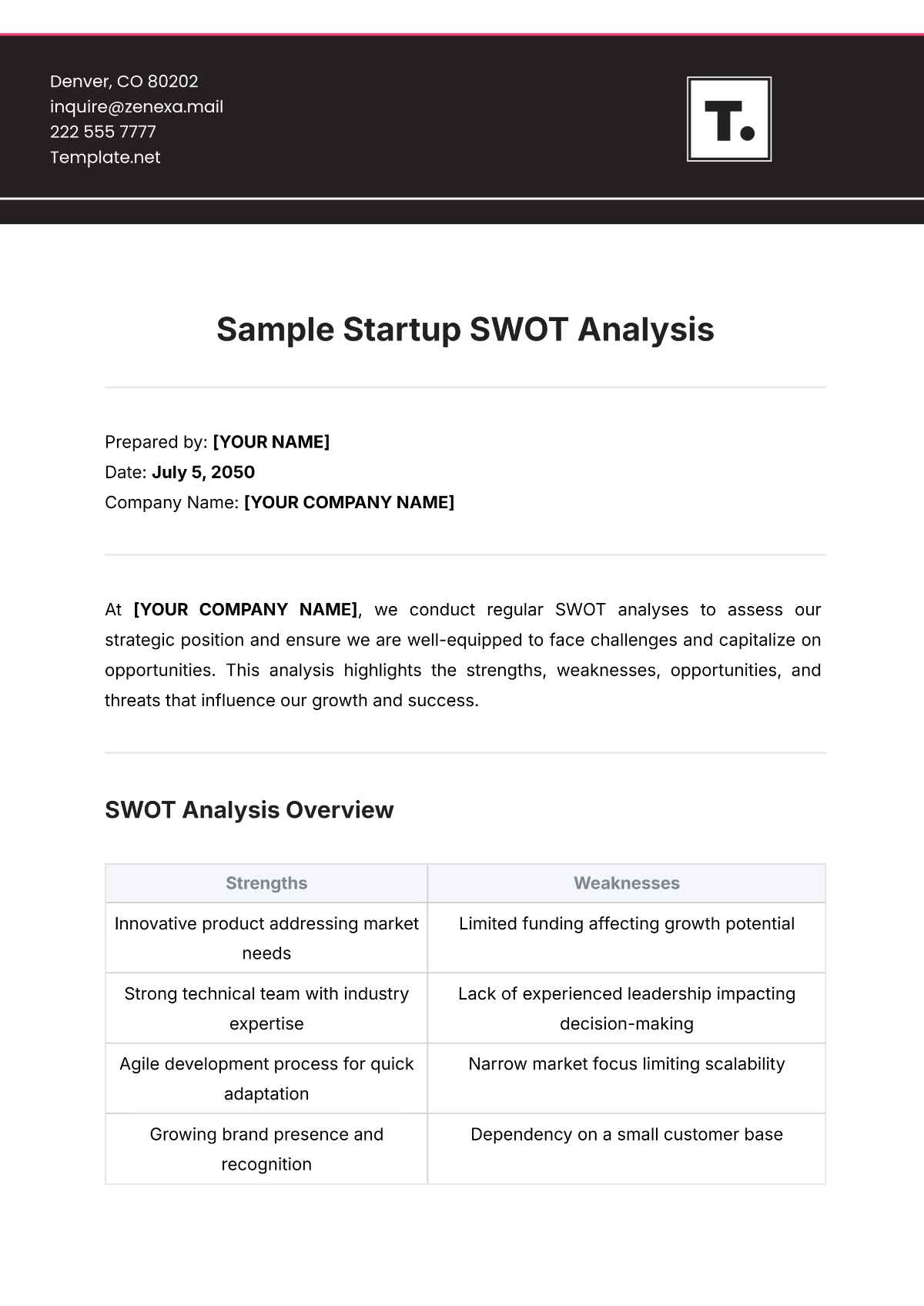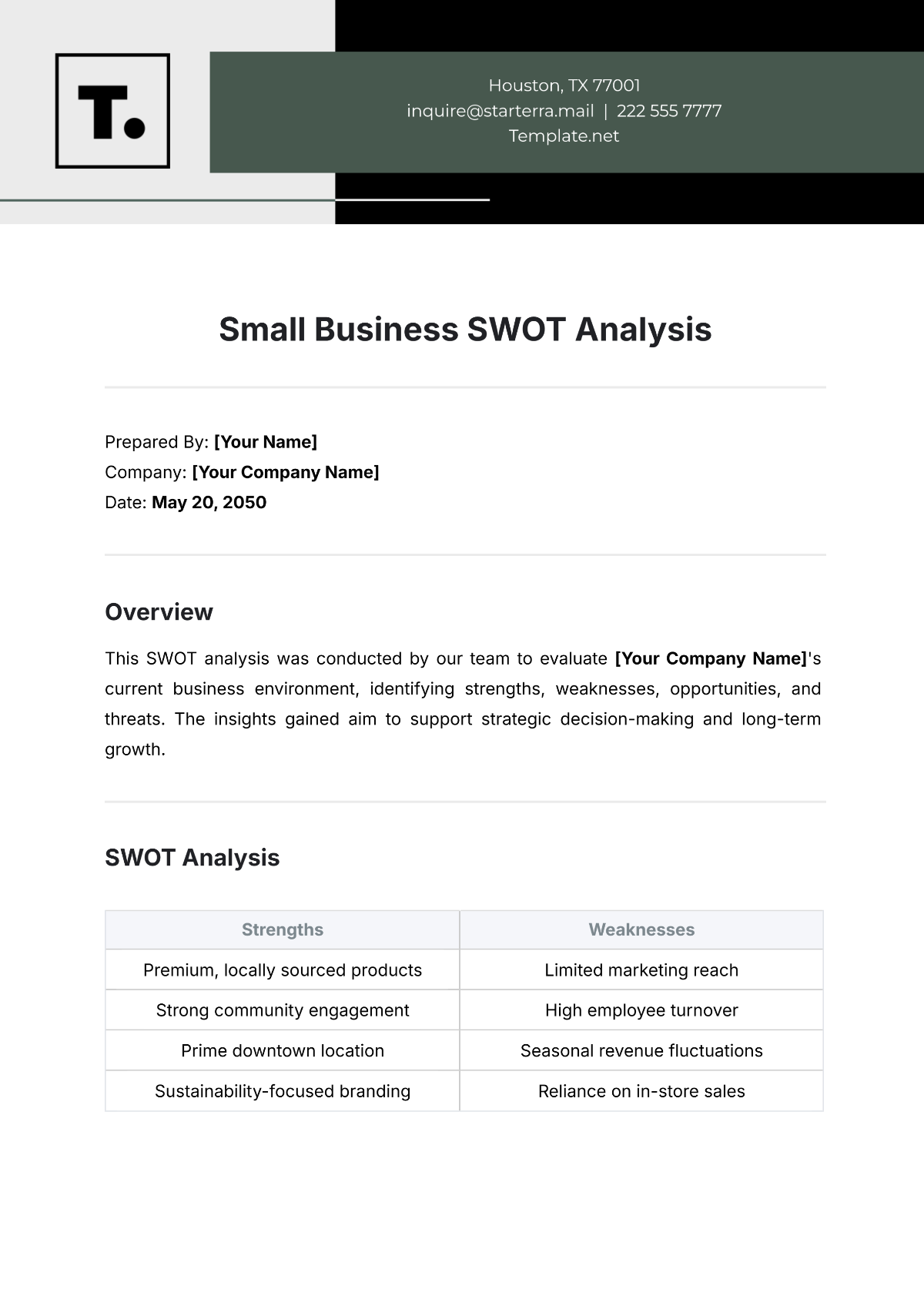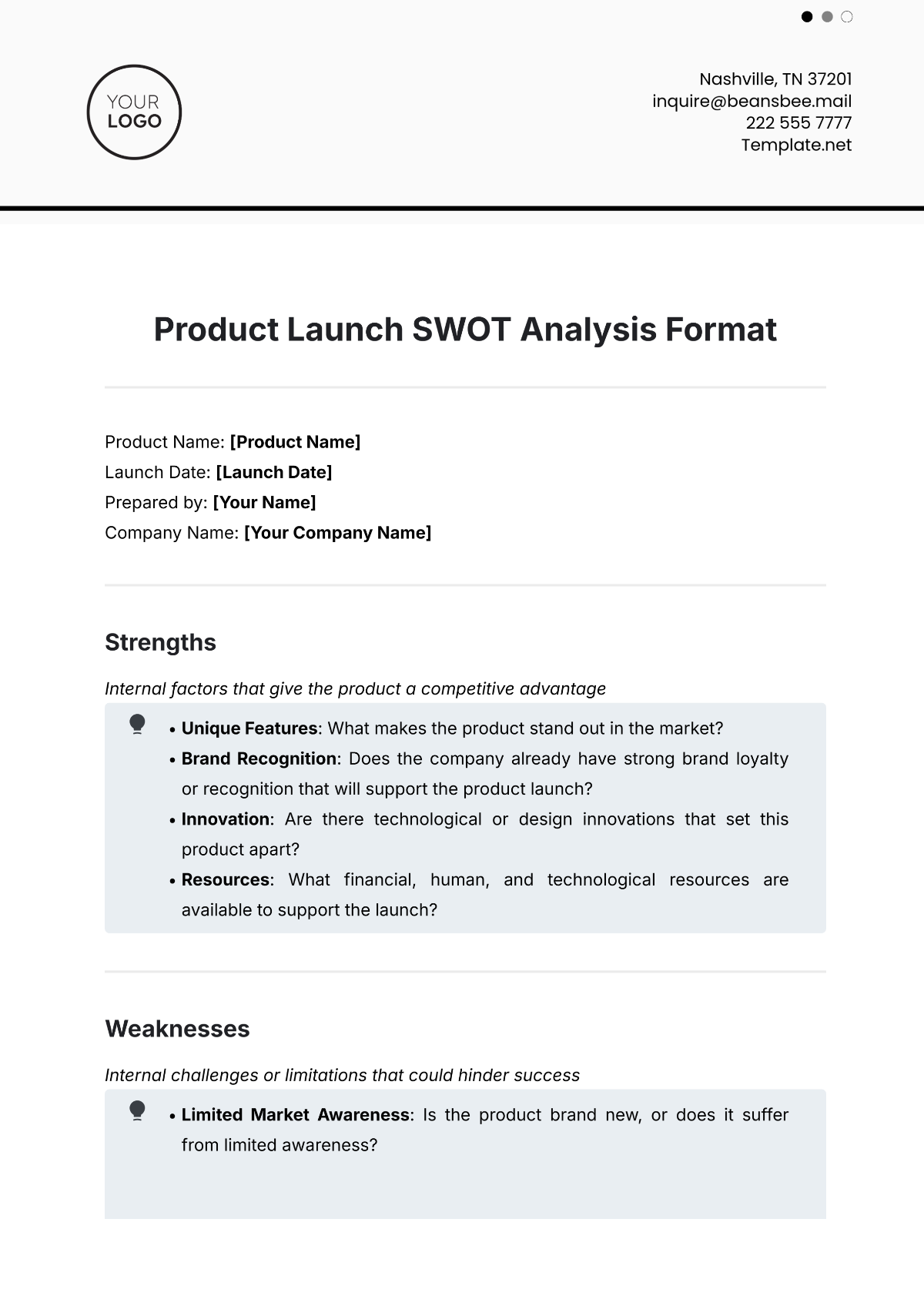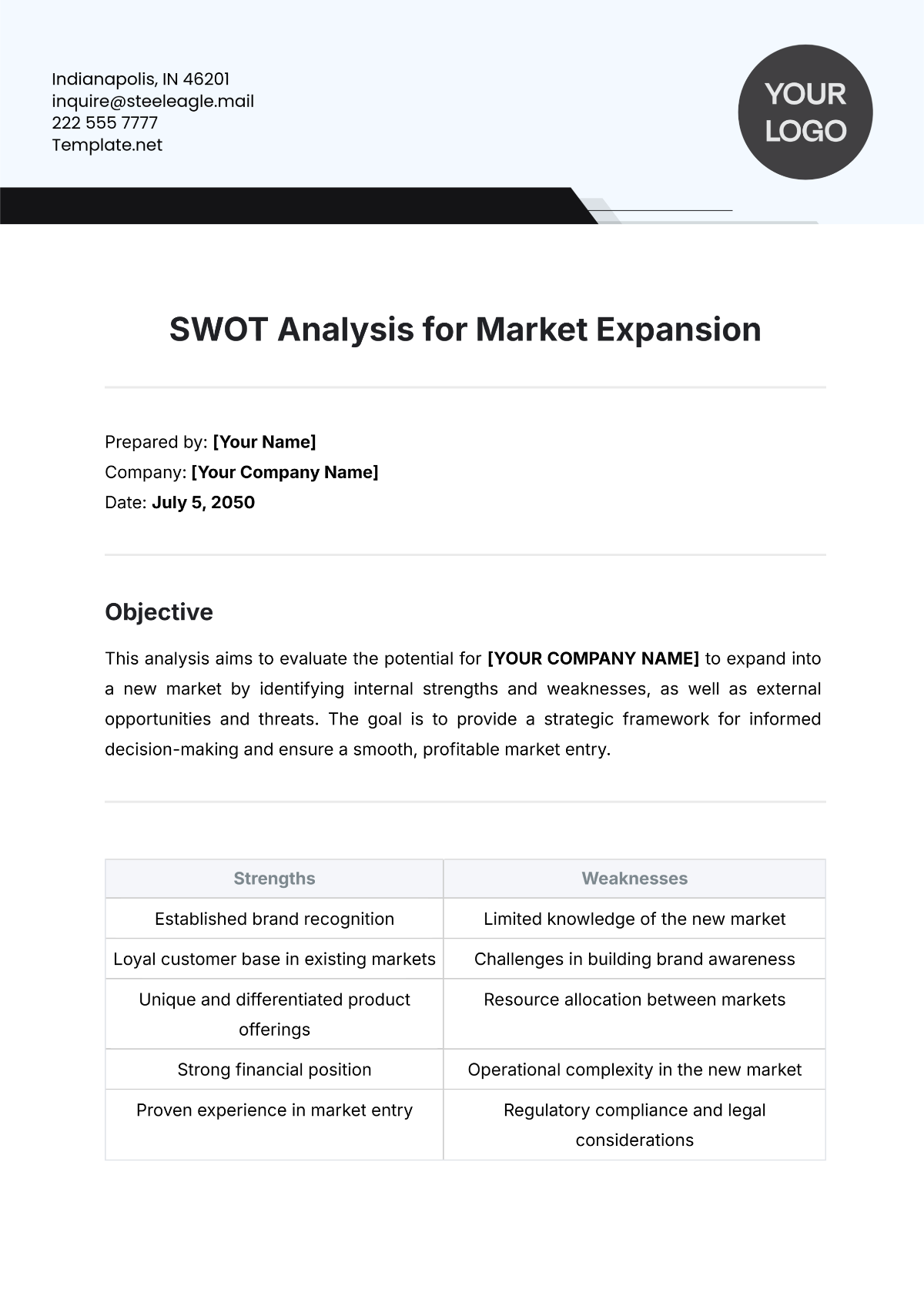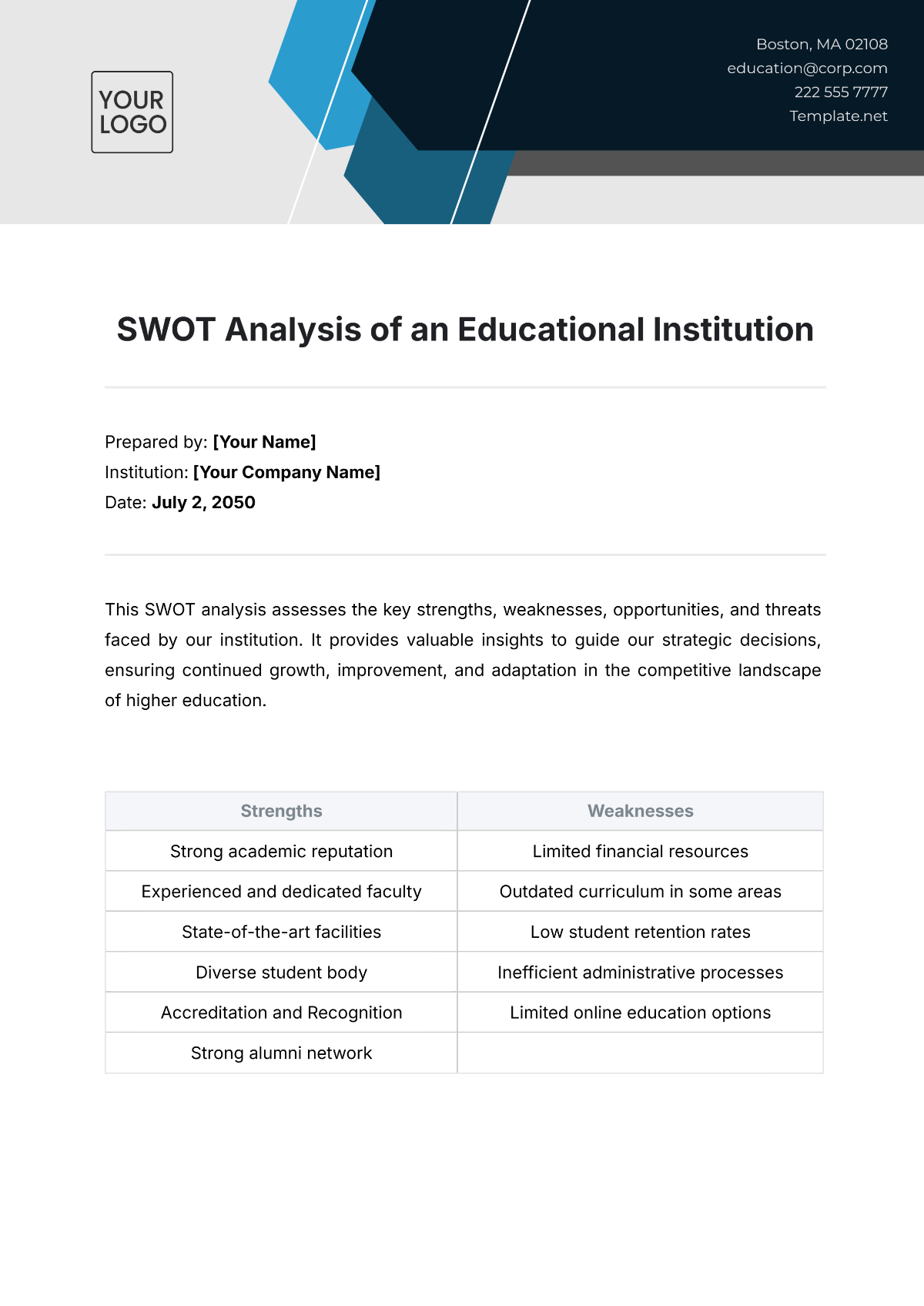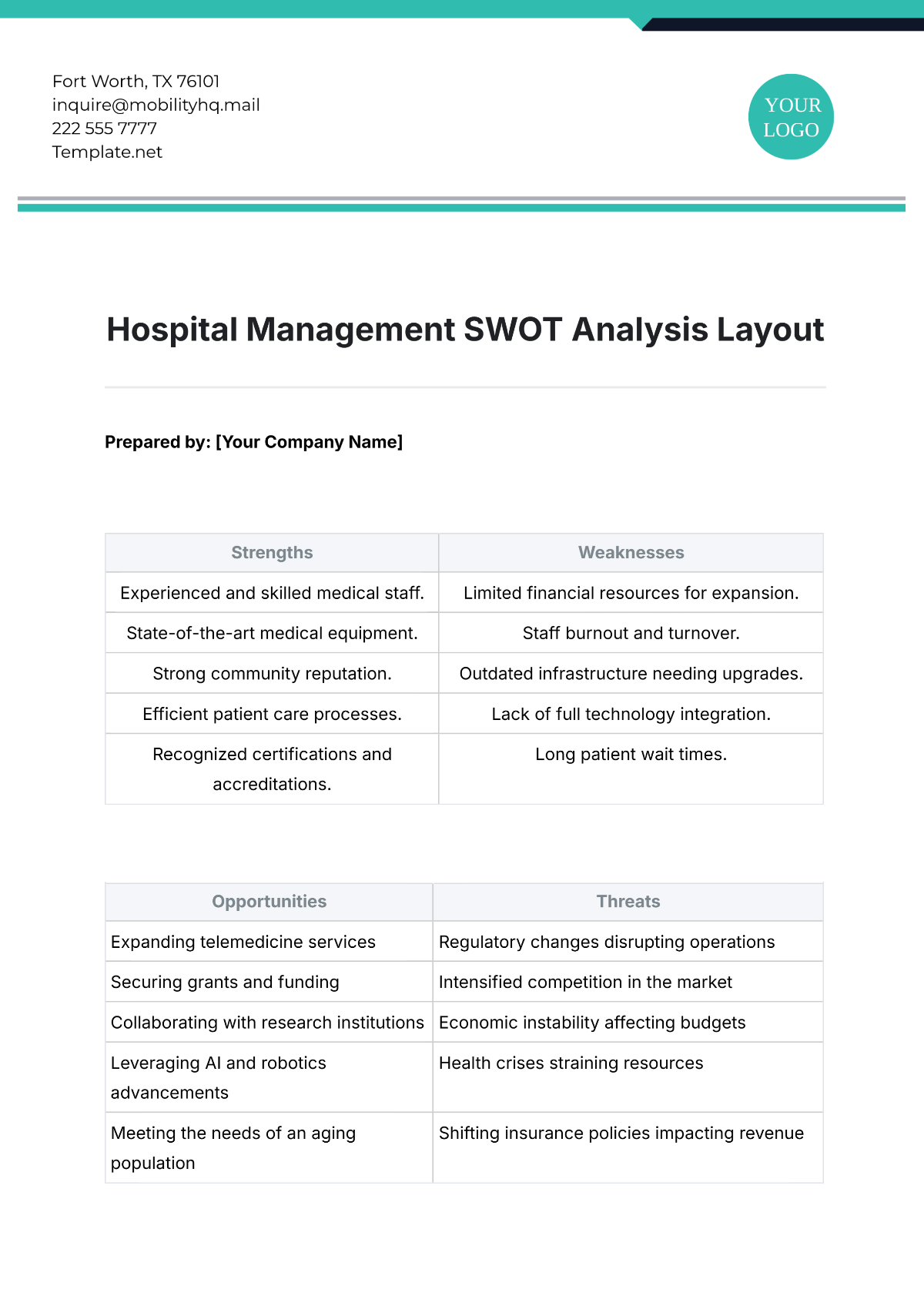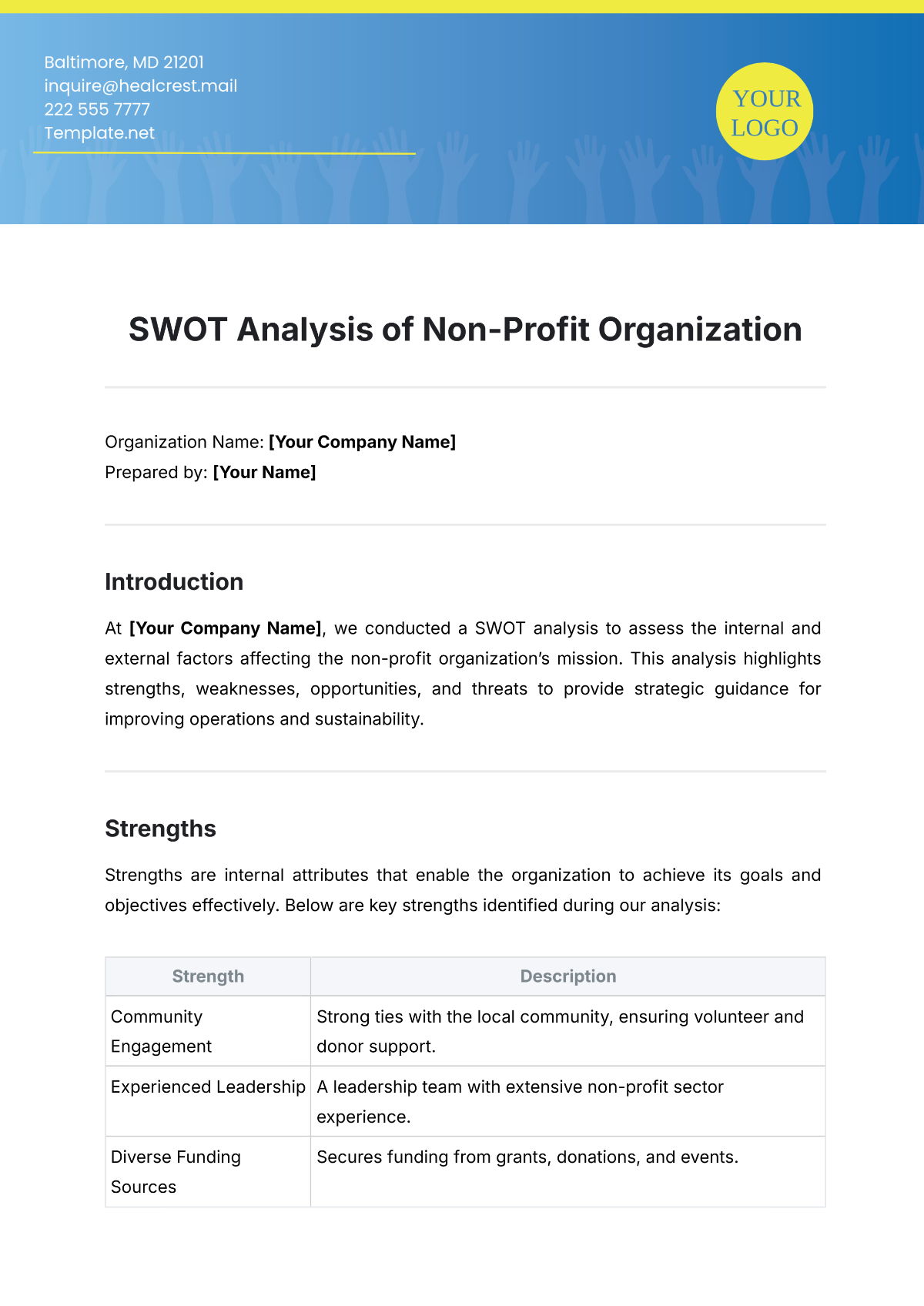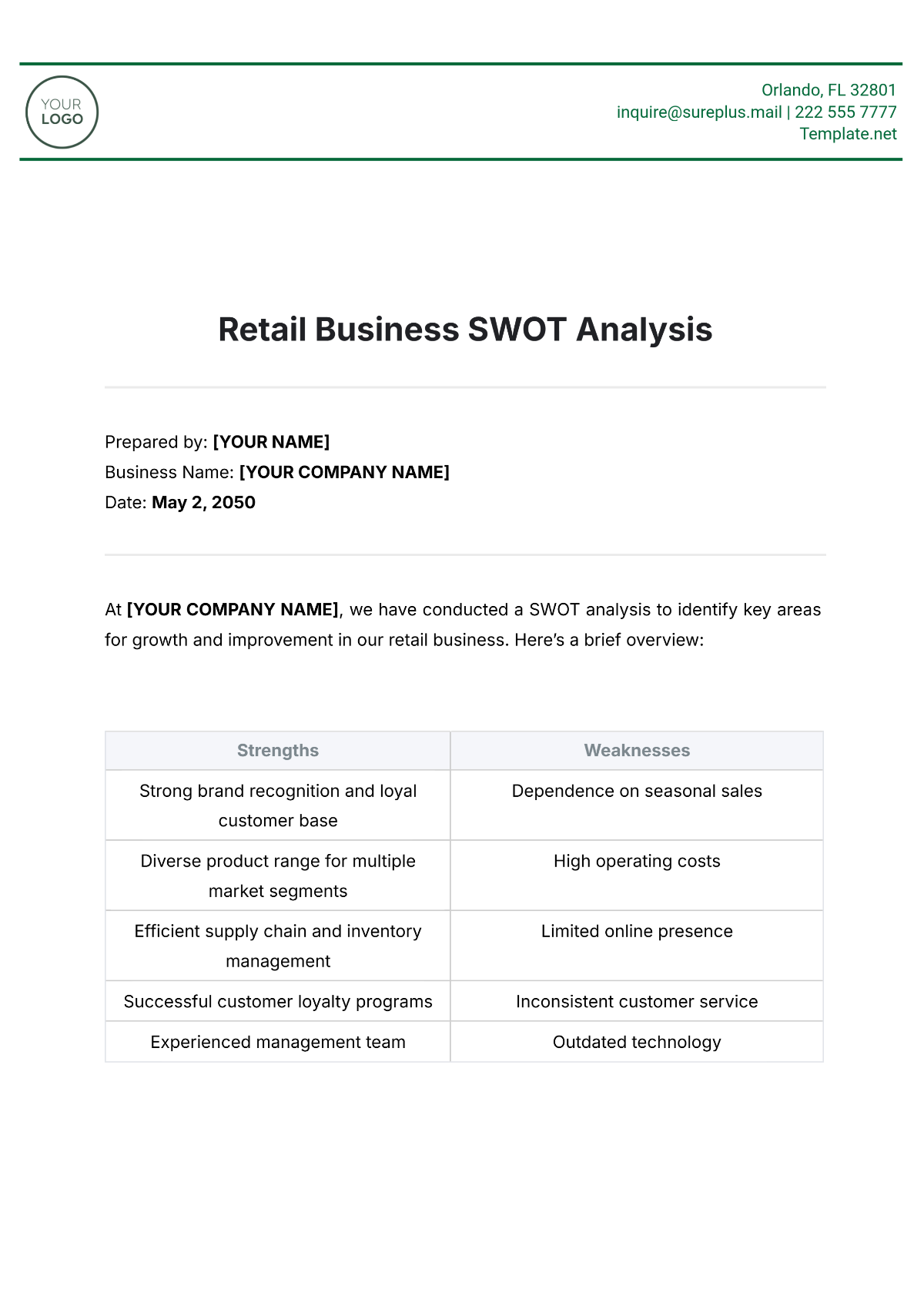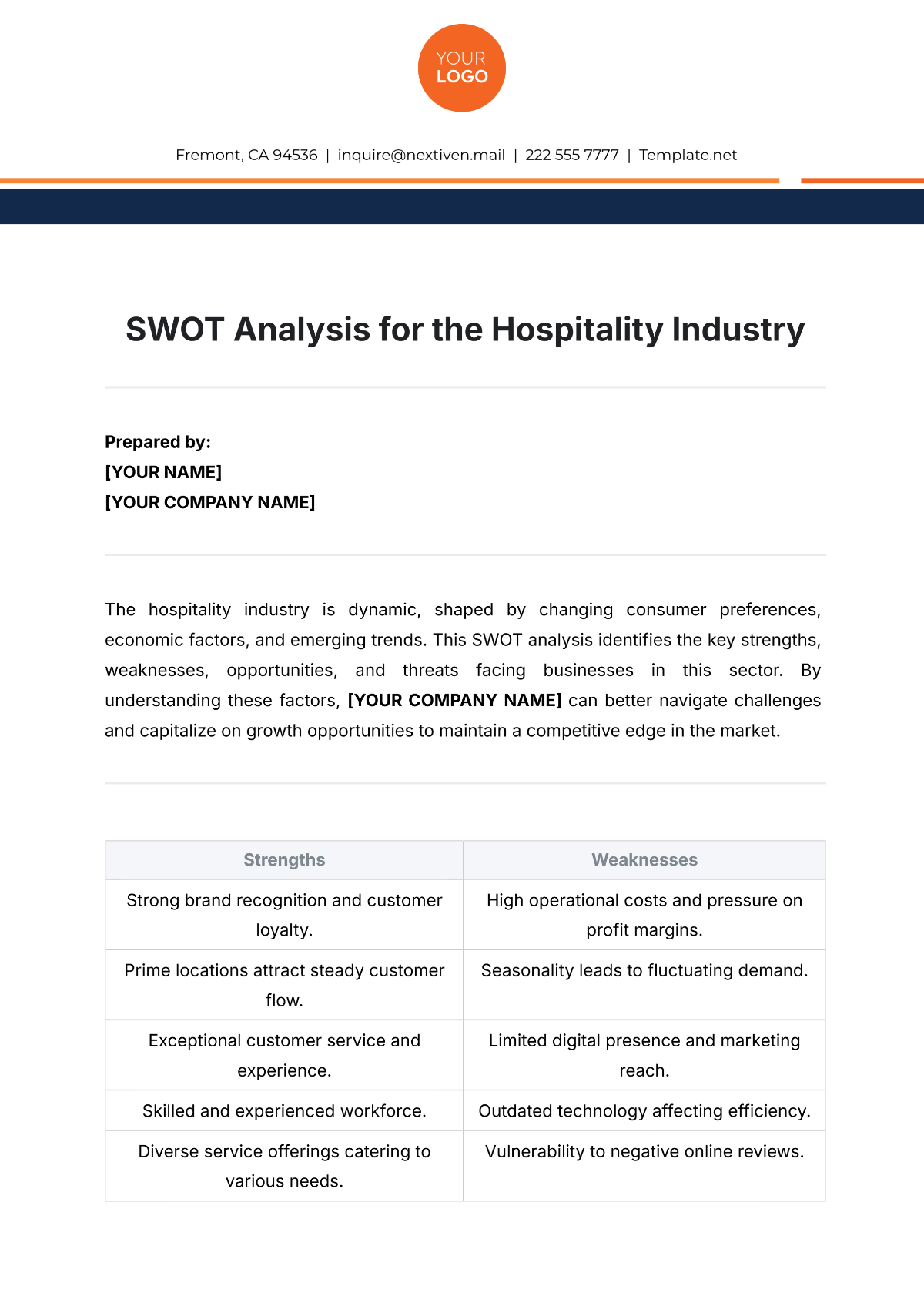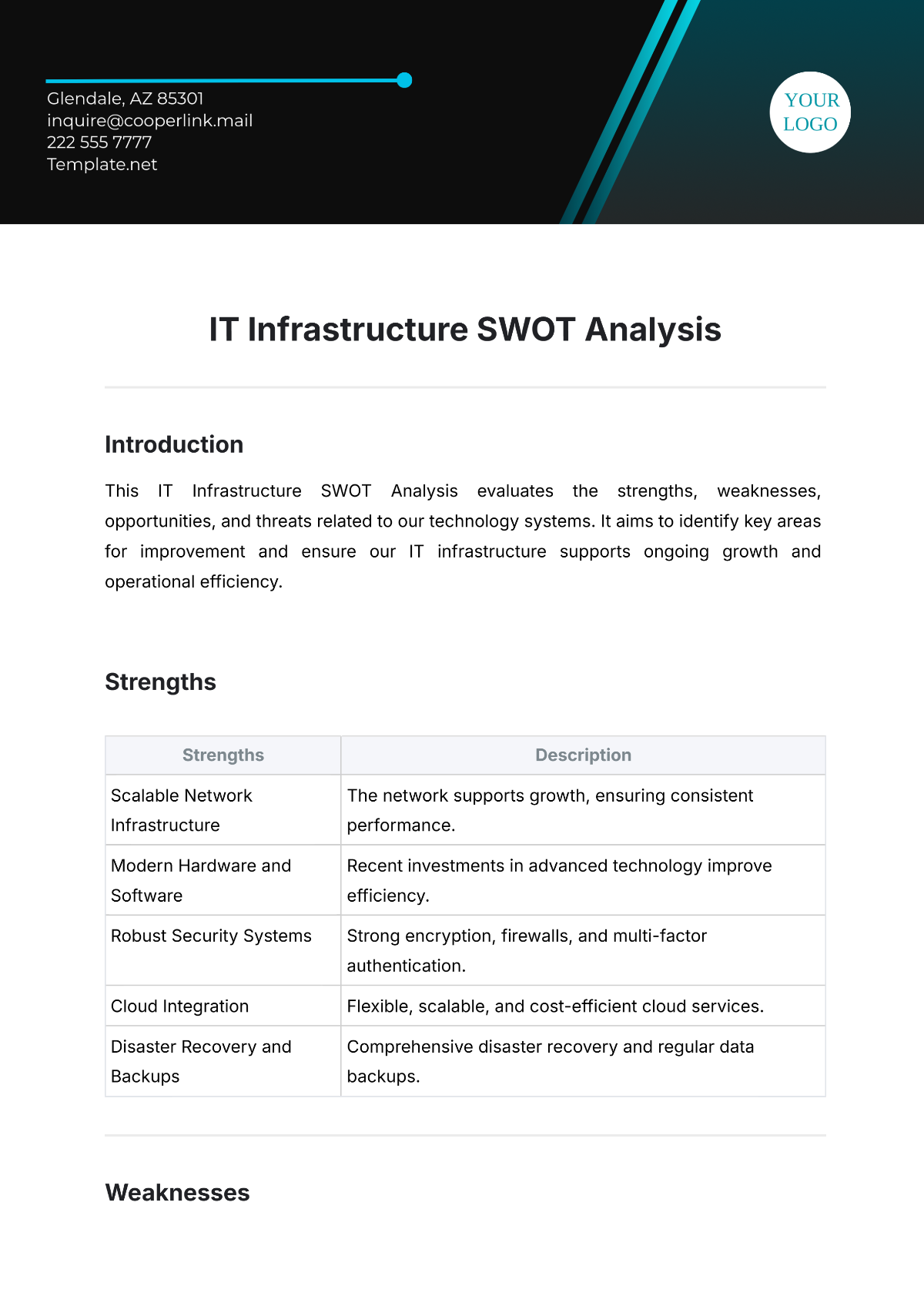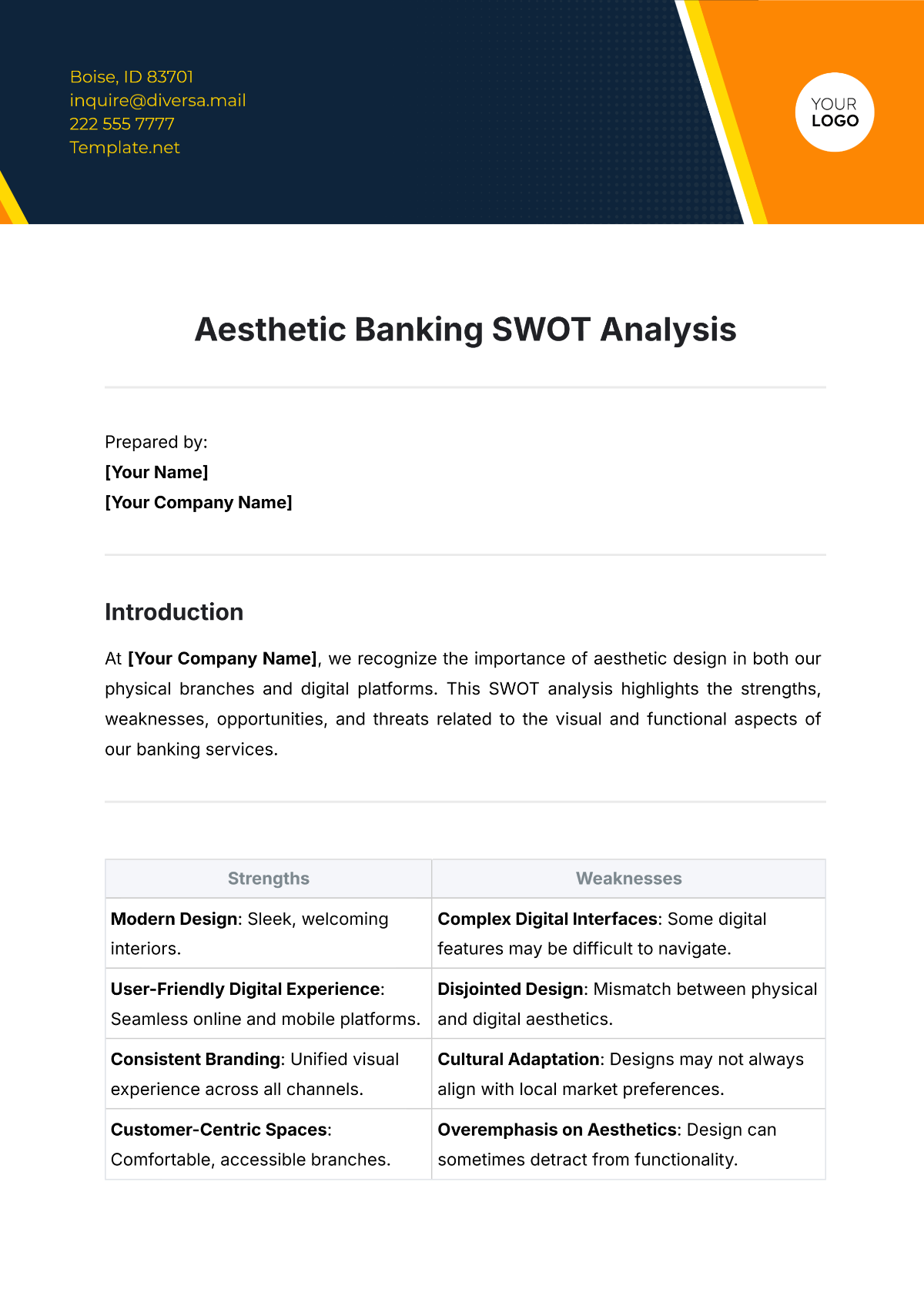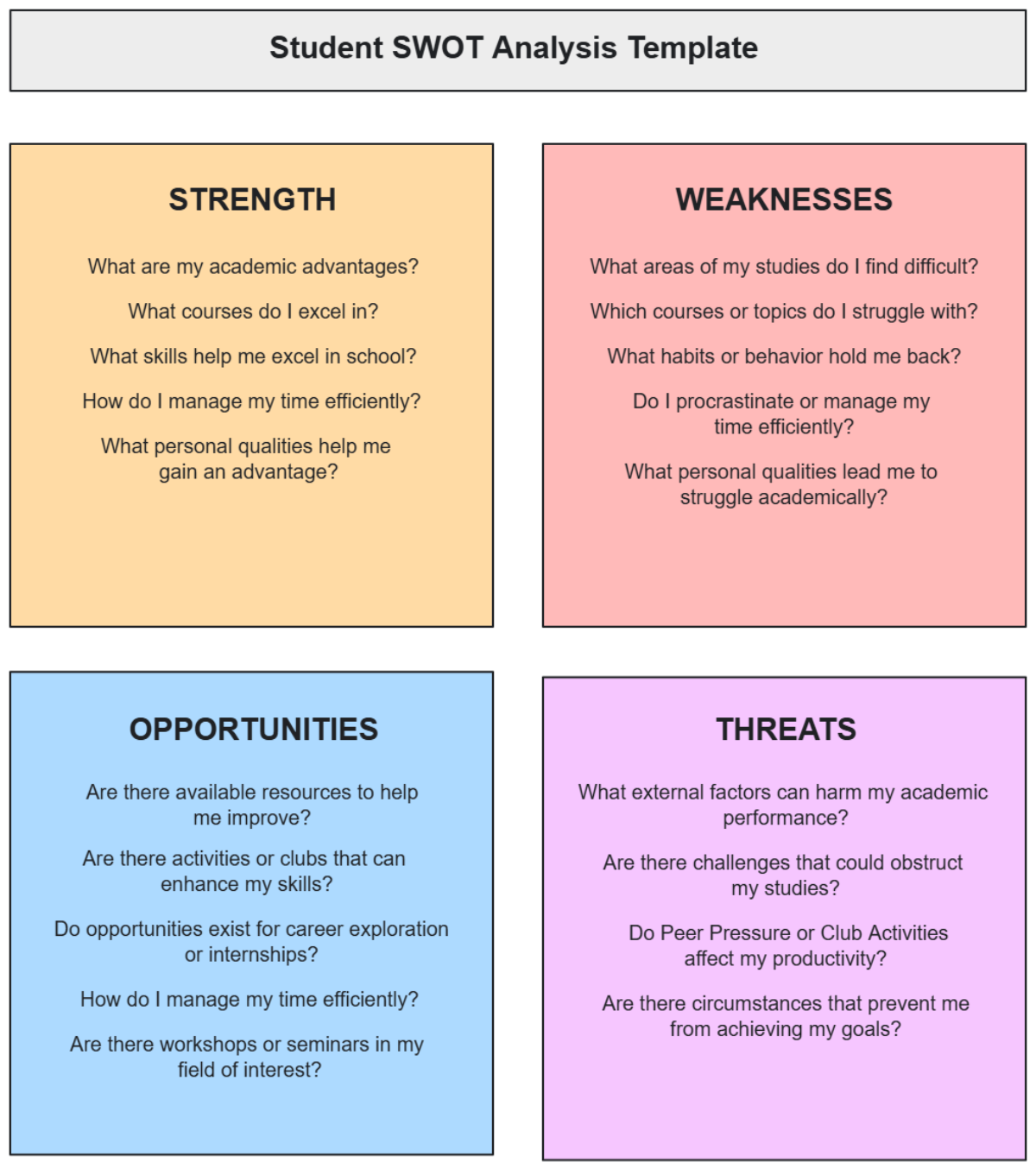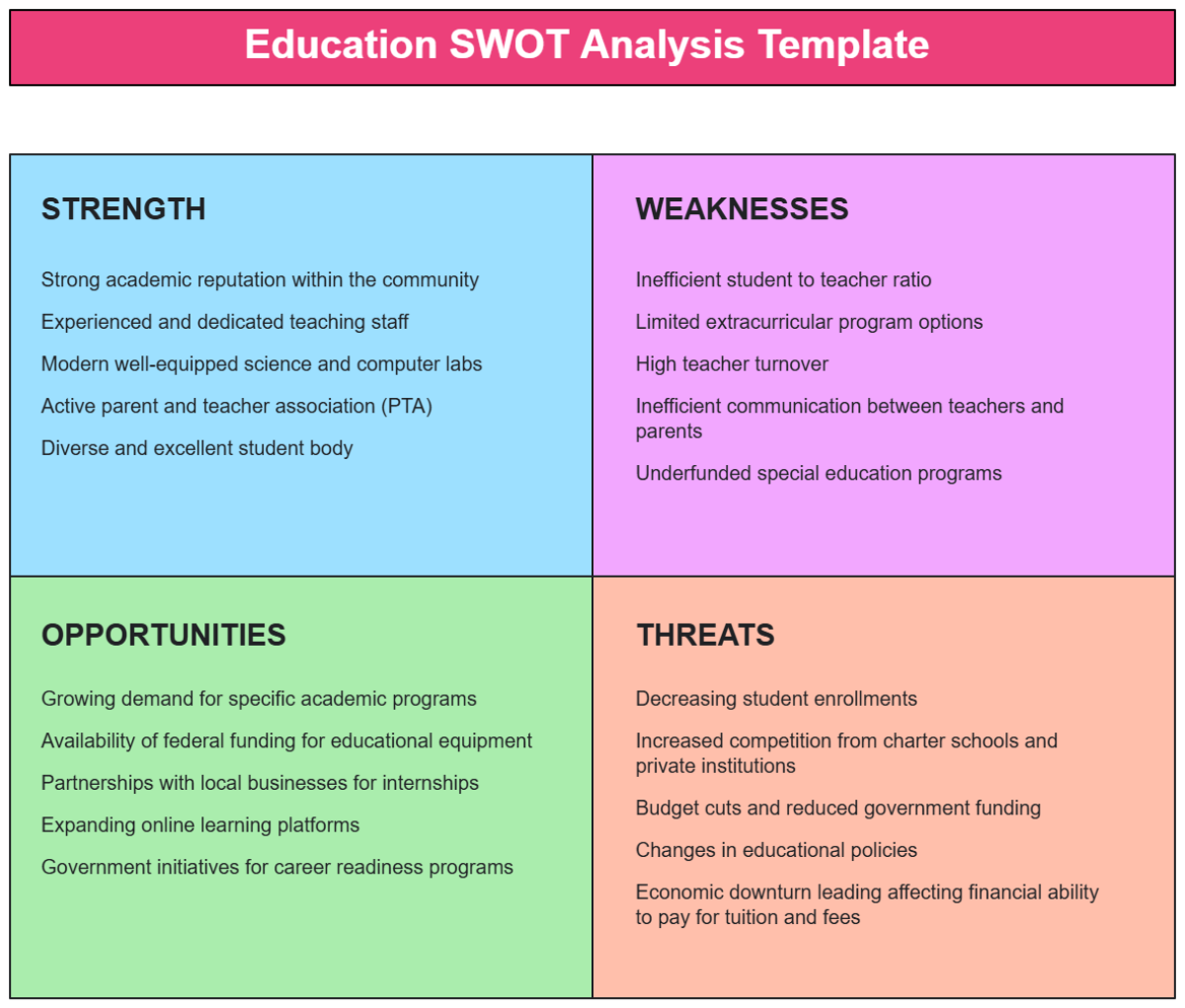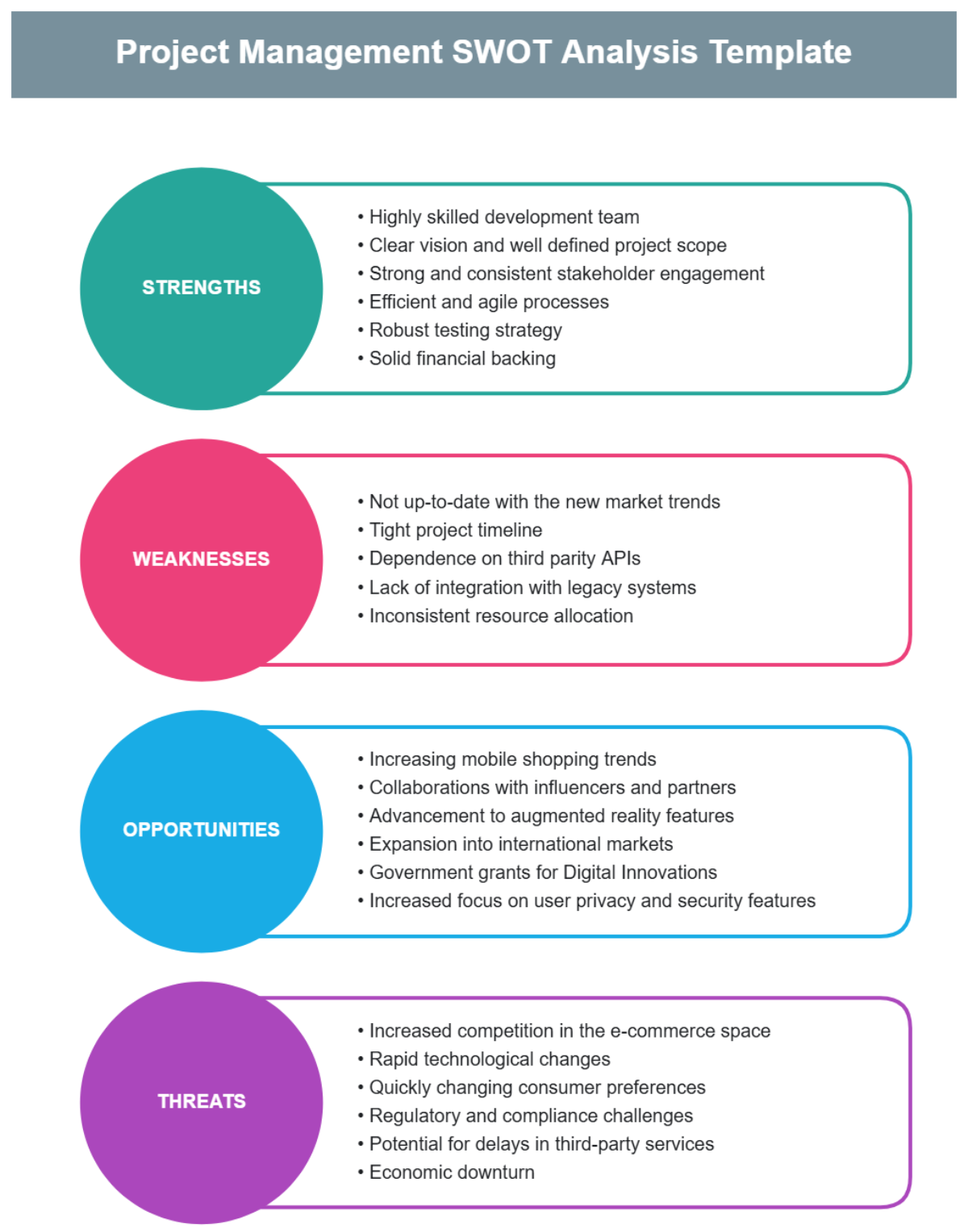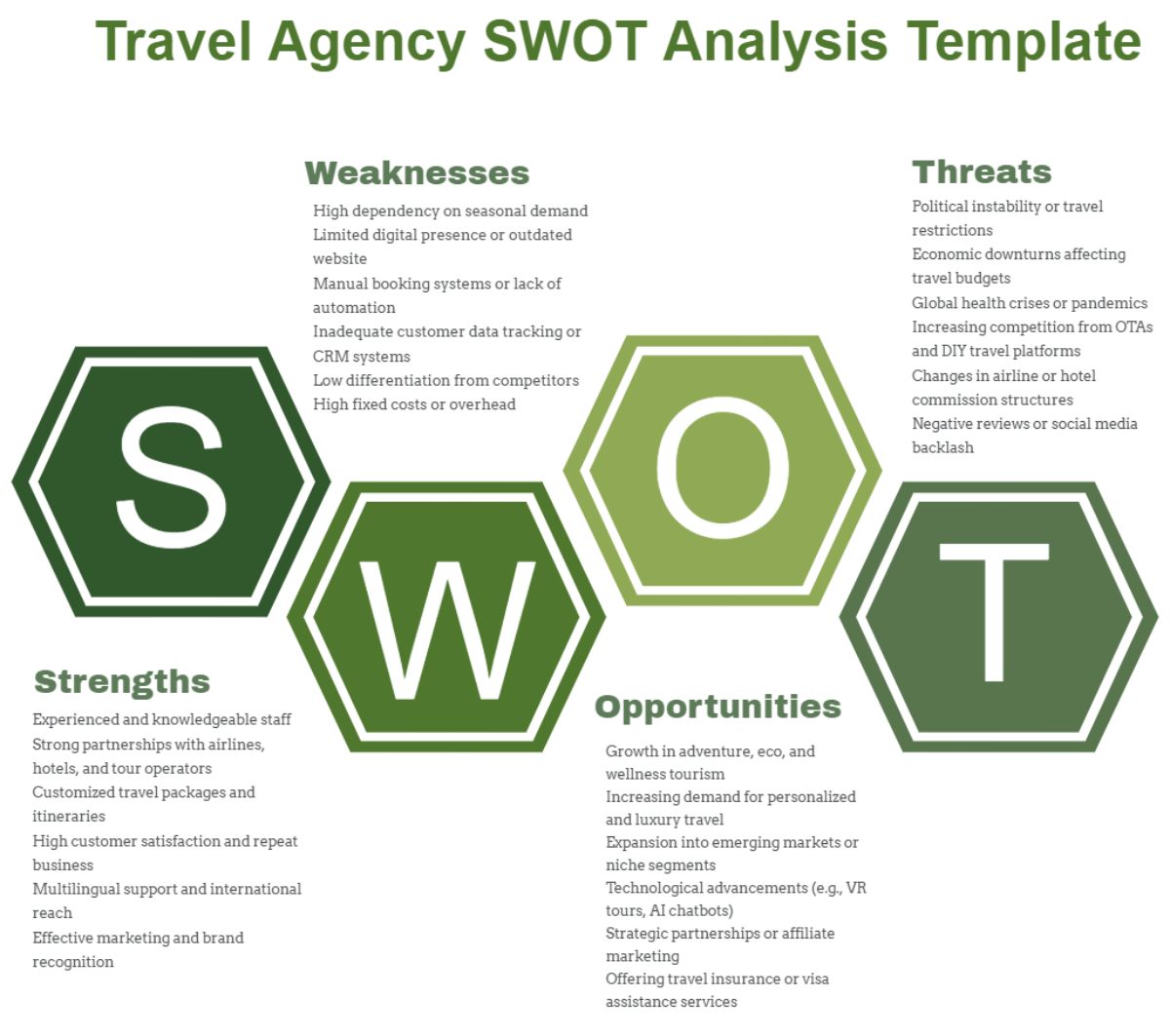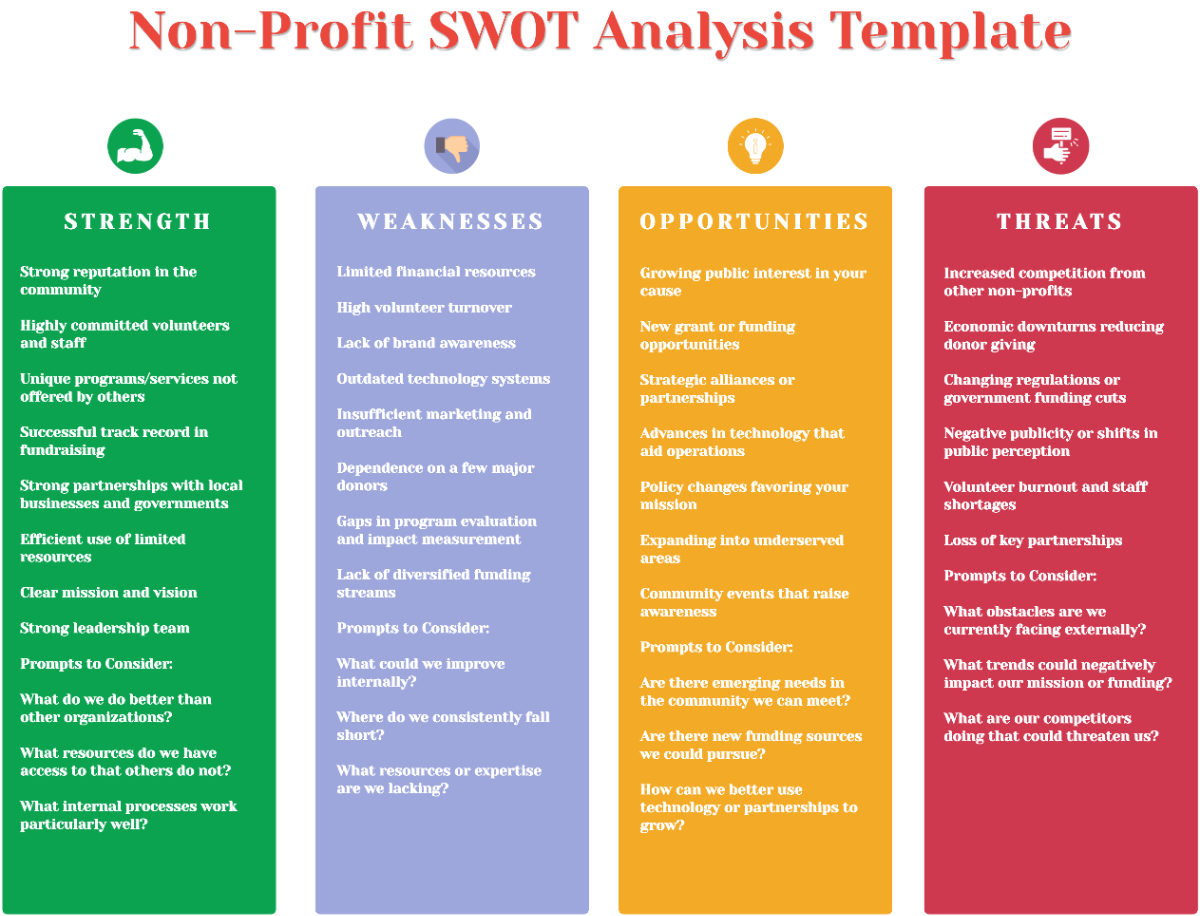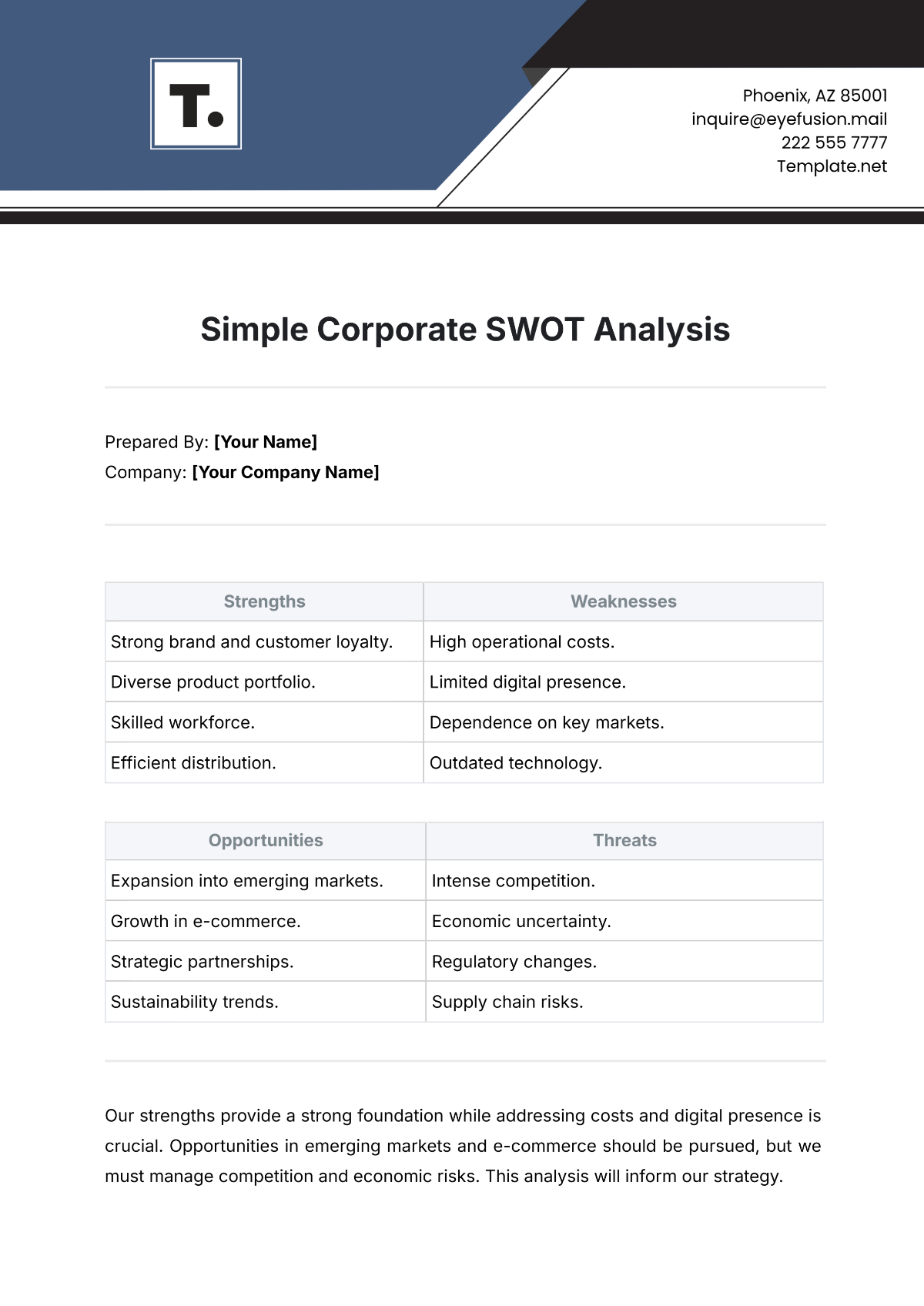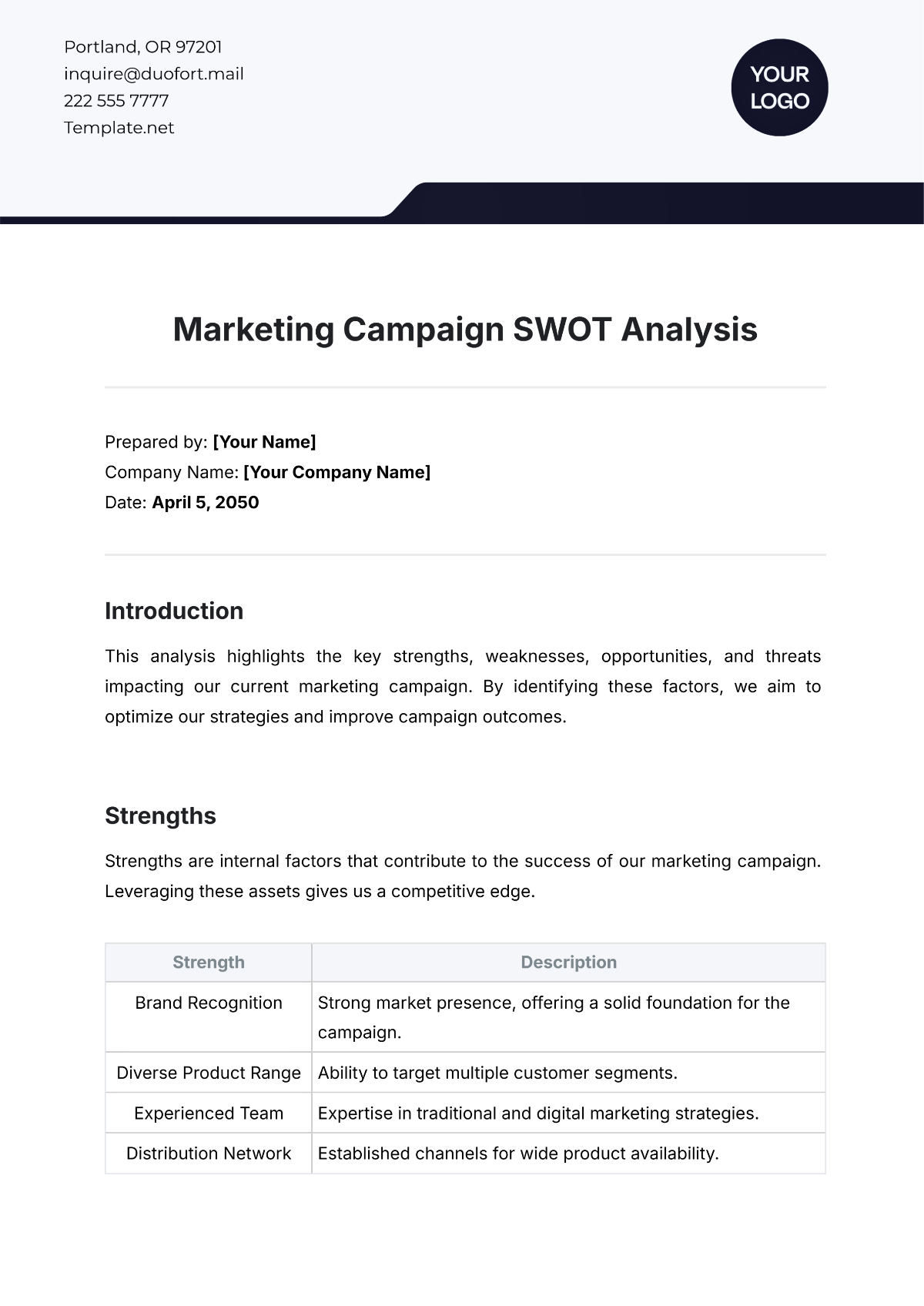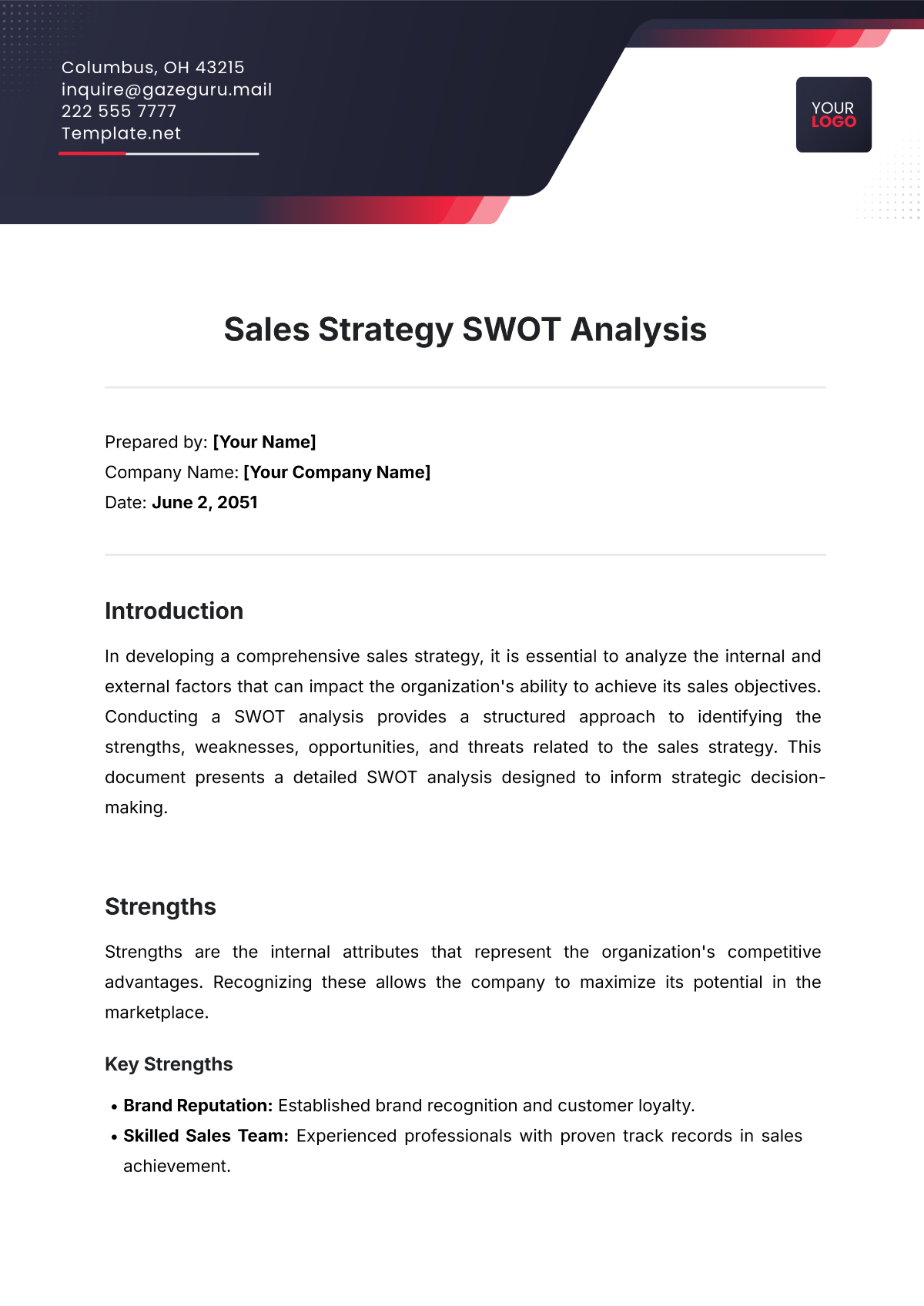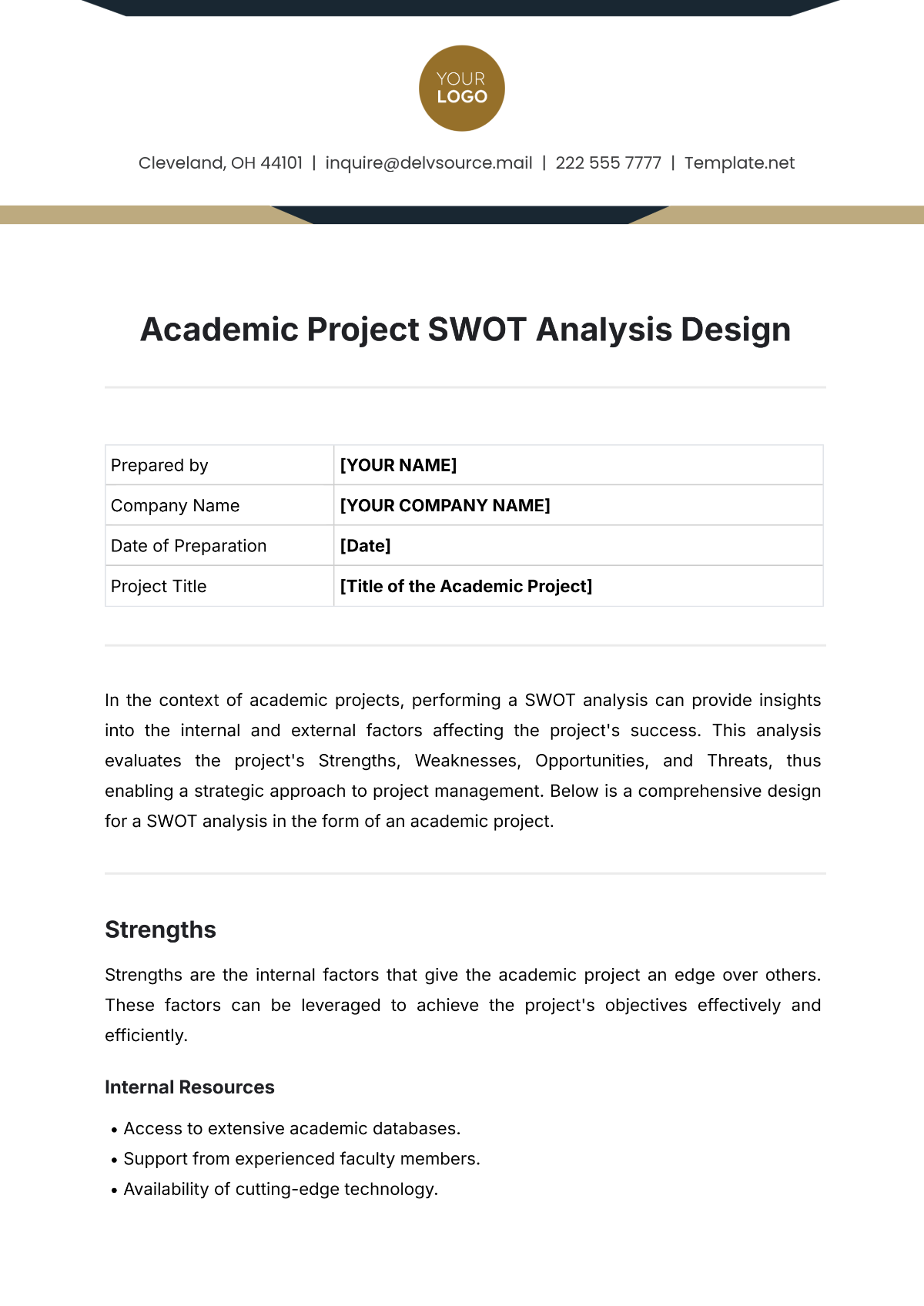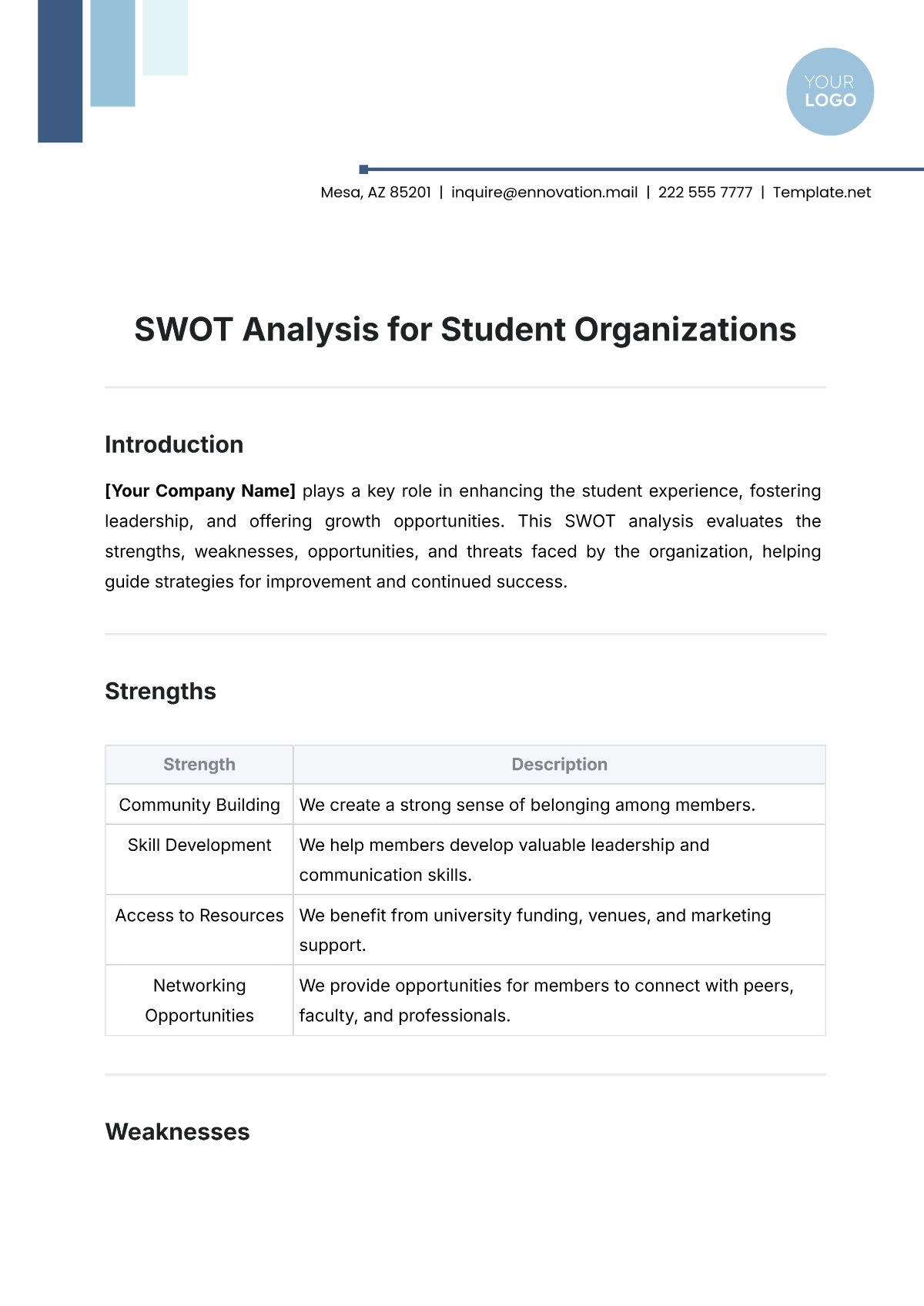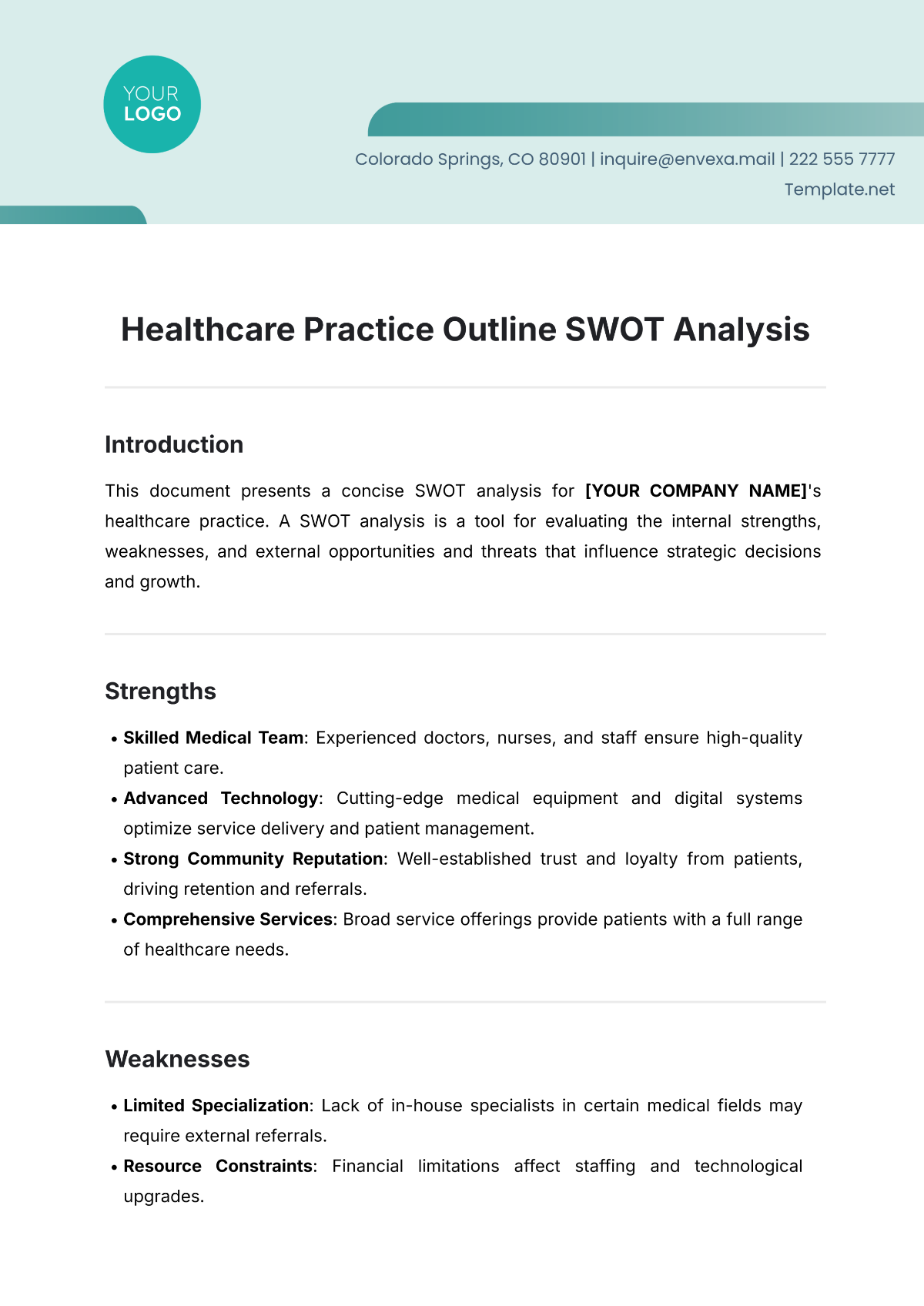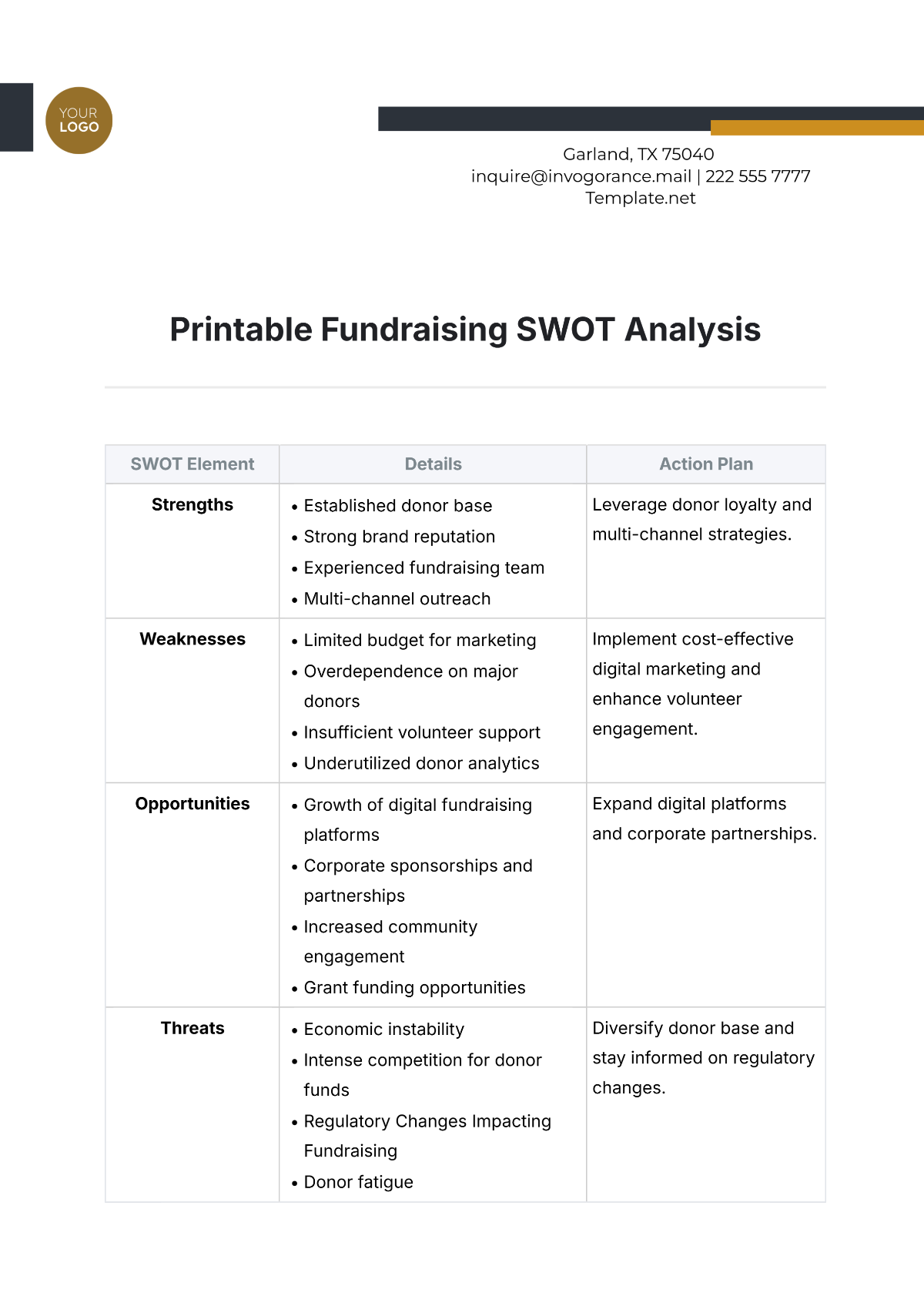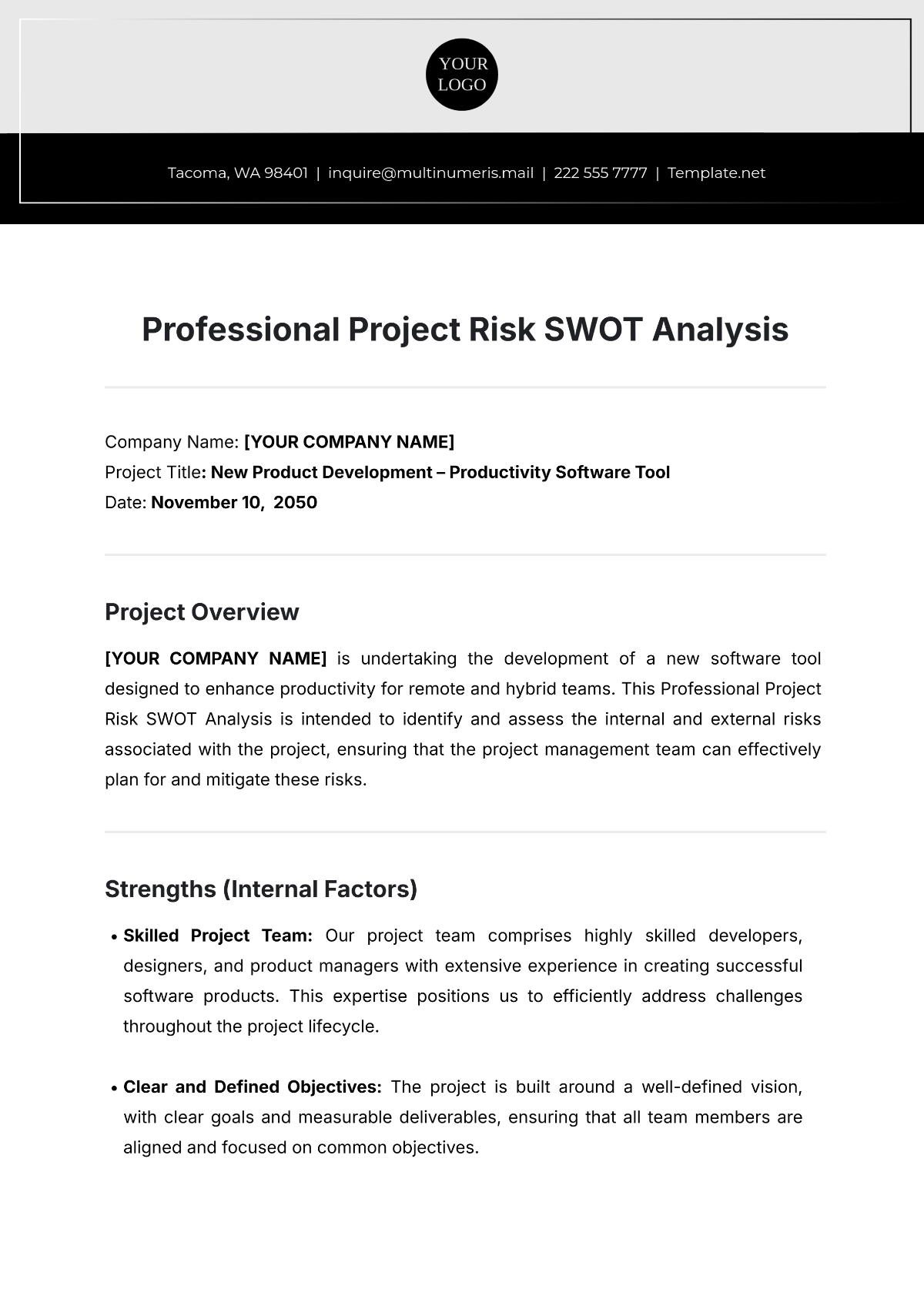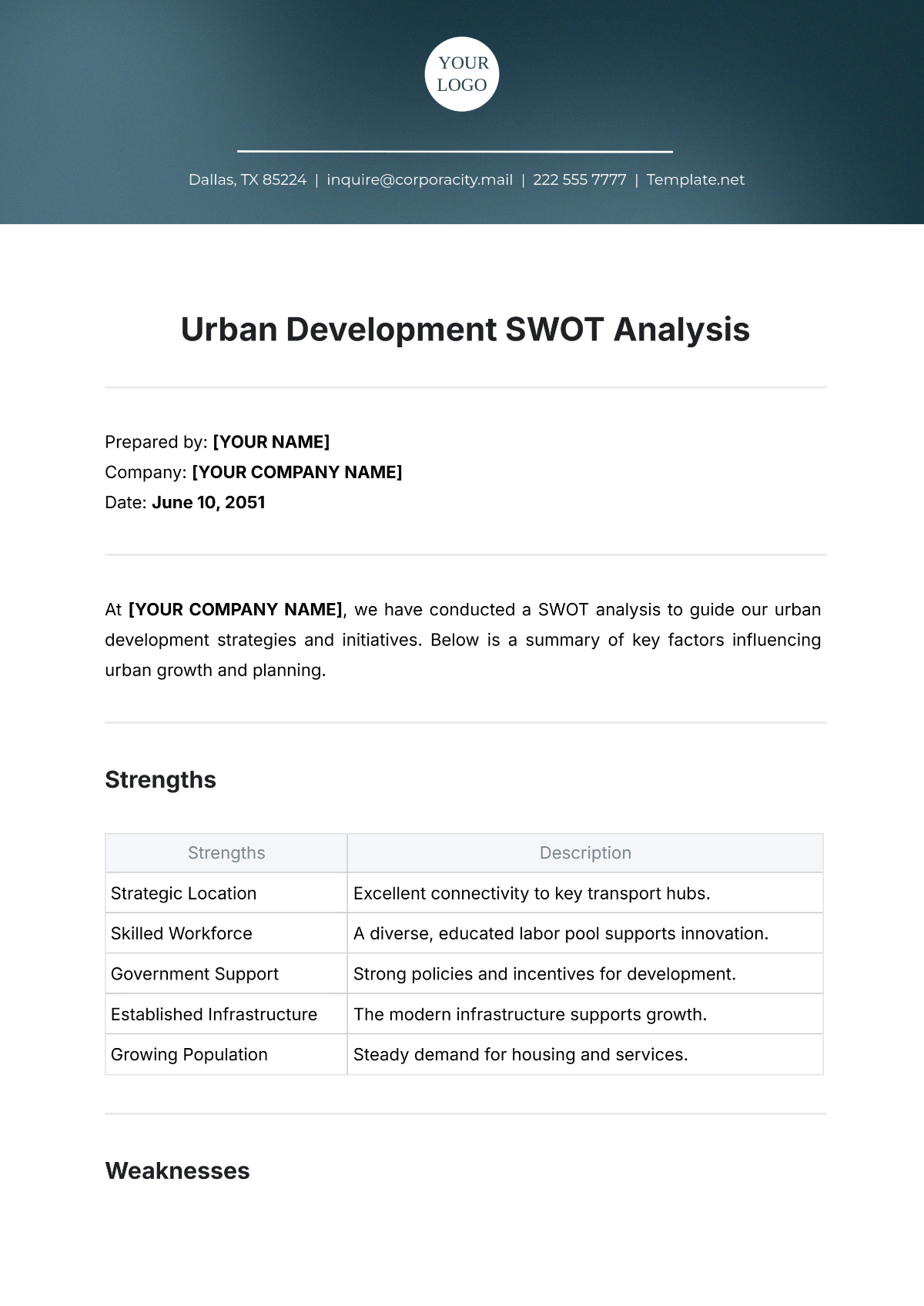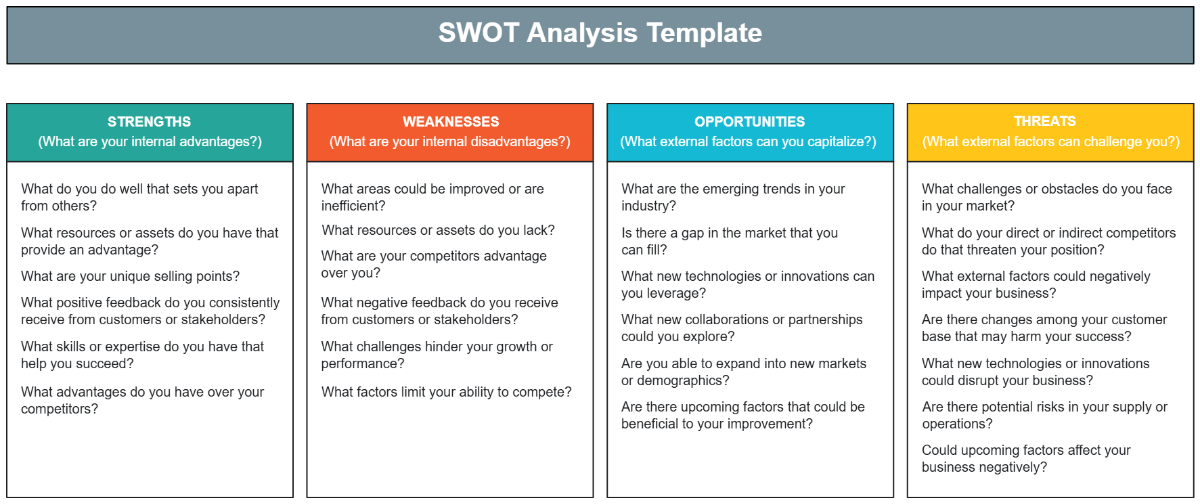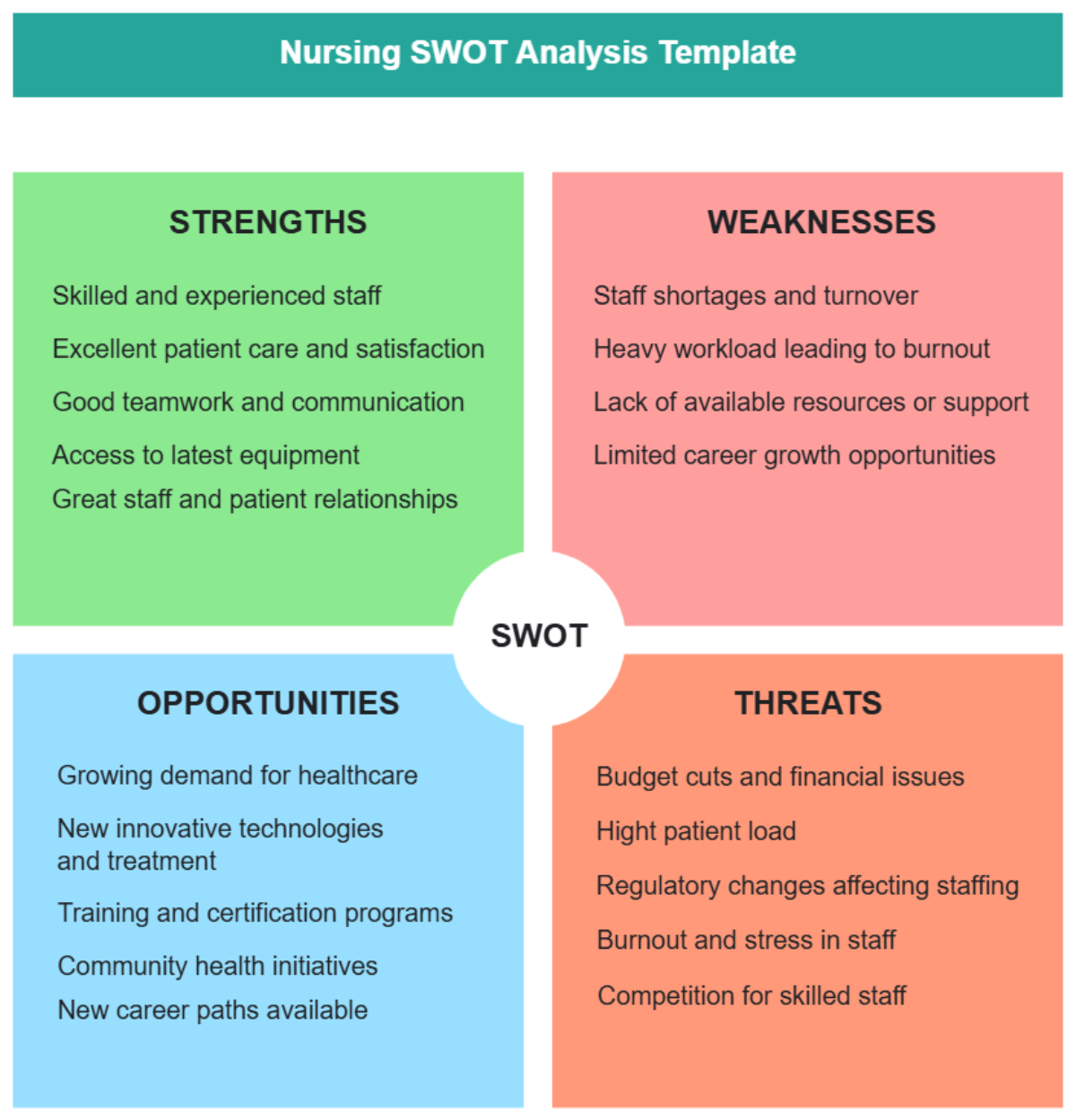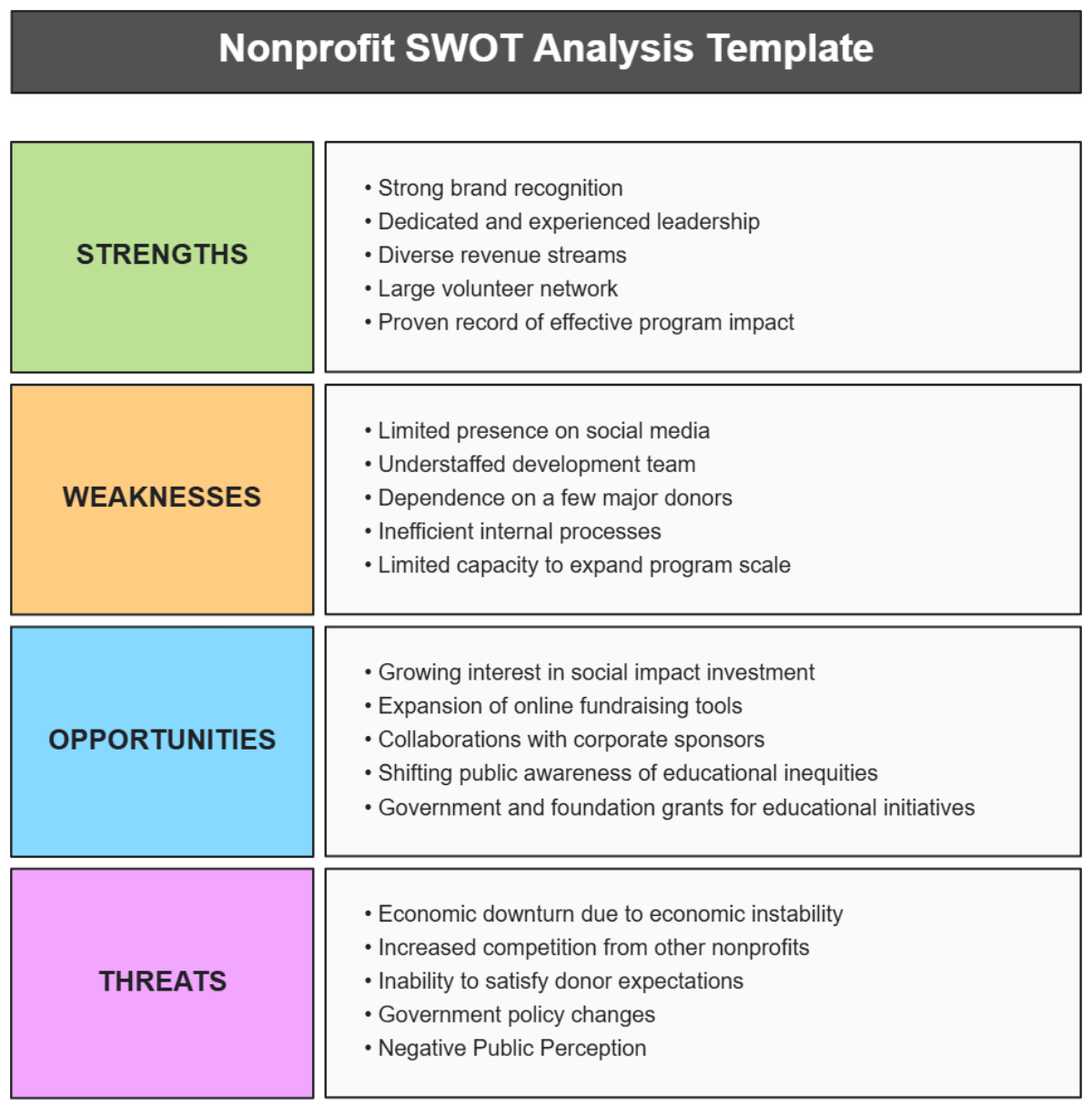Spa SWOT Analysis
I. Executive Summary
This Spa SWOT Analysis provides a comprehensive assessment of [Your Company Name]'s current market position, highlighting key strengths, weaknesses, opportunities, and threats. Our analysis reveals that [Your Company Name] benefits from a strong reputation, a prime location, and a highly skilled team, which contribute significantly to its competitive edge. However, challenges such as high employee turnover and outdated facilities need to be addressed to maintain and improve our market position.
Externally, the spa industry presents several opportunities, including increasing consumer interest in wellness and beauty treatments, as well as potential partnerships with local businesses. However, the market also poses threats such as intense competition and economic fluctuations, which could impact our profitability.
To leverage our strengths and opportunities, we recommend investing in staff retention programs, upgrading our facilities, and enhancing our marketing strategies to attract new customers. Additionally, forming strategic partnerships and expanding our service offerings can help mitigate threats and capitalize on emerging market trends. By addressing these areas, [Your Company Name] can strengthen its market position and achieve sustained growth.
II. Introduction
[Your Company Name] is a premier spa located in [Your Company Address], dedicated to providing top-notch wellness and beauty services to our clientele. Established in [2050], our spa has earned a reputation for excellence, offering a wide range of treatments including massages, facials, body treatments, and specialized wellness therapies. Our mission is to promote relaxation, rejuvenation, and holistic well-being for all our clients, ensuring a luxurious and serene experience with each visit.
Industry Overview
The spa industry is a significant segment of the broader wellness market, encompassing a variety of services aimed at enhancing physical, mental, and emotional well-being. According to recent industry reports, the global spa market has been experiencing steady growth, driven by increasing consumer awareness of health and wellness, a rise in disposable income, and a growing preference for stress-relief treatments. The industry is expected to continue expanding, with projections indicating a compound annual growth rate (CAGR) of [0]% over the next five years.
Market Dynamics
Several key trends are shaping the spa industry. First, there is a growing demand for personalized and tailored wellness experiences, as clients seek treatments that address their specific needs and preferences. This trend is driving spas to innovate and diversify their service offerings, incorporating advanced technologies and holistic approaches. Additionally, the integration of health and wellness into everyday lifestyle choices has led to a rise in demand for preventive and therapeutic treatments.
Sustainability and eco-friendliness are also becoming important considerations for consumers, prompting spas to adopt green practices and use organic, natural products. Furthermore, the rise of digitalization in the wellness sector has led to the development of online booking systems, virtual consultations, and digital wellness programs, enhancing the overall customer experience.
Competitive Landscape
The spa industry is highly competitive, with a mix of well-established brands and numerous smaller, boutique spas vying for market share. Key competitive factors include service quality, customer experience, pricing, location, and brand reputation. To remain competitive, [Your Company Name] focuses on delivering exceptional customer service, continuously training our staff, and staying abreast of industry trends and innovations.
In this context, a SWOT analysis is a valuable tool for identifying the internal and external factors that influence our business. By understanding our strengths, weaknesses, opportunities, and threats, [Your Company Name] can develop effective strategies to enhance our market position and achieve sustainable growth.
III. Methodology
The SWOT analysis for [Your Company Name] was conducted using a systematic approach to ensure a thorough and objective assessment of our spa business. This involved several steps, utilizing both qualitative and quantitative data sources to capture a comprehensive view of our internal and external environment.
Data Collection
To conduct a comprehensive SWOT analysis, we employed a multi-faceted data collection approach. This included reviewing internal data, conducting stakeholder interviews, analyzing competitors, and performing market research to gather valuable insights about [Your Company Name]'s strengths, weaknesses, opportunities, and threats.
Internal Data Review: We began by gathering internal data, including financial reports, customer feedback, employee performance reviews, and operational metrics. This provided insight into our strengths and weaknesses.
Stakeholder Interviews: We conducted interviews with key stakeholders, including management, staff, and loyal customers. These interviews helped us gain a deeper understanding of our operational capabilities, service quality, and customer satisfaction levels.
Competitive Analysis: We analyzed the competitive landscape by studying our primary competitors. This involved reviewing their service offerings, pricing strategies, marketing efforts, and customer reviews. This helped us identify areas where we excel and areas that require improvement.
Market Research: We conducted extensive market research to understand industry trends, consumer behavior, and emerging opportunities. This included reviewing industry reports, attending trade shows, and monitoring relevant publications and online forums.
Data Analysis
In analyzing the collected data, we identified key internal strengths and weaknesses, as well as external opportunities and threats. This comprehensive assessment allowed us to understand [Your Company Name]'s current position and potential areas for growth and improvement.
Strengths and Weaknesses: Internal data and stakeholder feedback were analyzed to identify the core strengths and weaknesses of [Your Company Name]. We focused on aspects such as service quality, operational efficiency, brand reputation, and employee expertise.
Opportunities and Threats: Market research and competitive analysis were used to identify external opportunities and threats. We examined industry trends, economic conditions, technological advancements, and regulatory changes that could impact our business.
SWOT Matrix Development
Using the insights gathered, we developed a SWOT matrix that categorizes the identified factors into strengths, weaknesses, opportunities, and threats. Each factor was carefully evaluated and prioritized based on its potential impact on our business.
Validation and Review
The preliminary SWOT matrix was reviewed by senior management to ensure accuracy and comprehensiveness. Feedback was incorporated to refine the analysis and develop strategic recommendations.
By following this methodology, we ensured a robust and actionable SWOT analysis that provides a clear understanding of [Your Company Name]'s current position and strategic direction.
IV. Internal Analysis (Strengths and Weaknesses)
In this section, we examine the internal factors that impact [Your Company Name]'s spa business, focusing on strengths that set us apart and weaknesses that need attention. The table below presents a summary of our internal analysis, highlighting key areas where we excel and areas that require improvement. By understanding these internal factors, we can develop strategies to capitalize on our strengths and address our weaknesses, ensuring continued success and competitiveness in the spa industry.
Strengths | Weaknesses |
|---|---|
Exceptional Service Quality | High Employee Turnover |
Prime Location | Outdated Facilities |
Skilled and Dedicated Staff | Limited Marketing Strategies |
Strong Brand Reputation | Operational Inefficiencies |
Diverse Service Offerings | Dependence on Seasonal Demand |
V. External Analysis (Opportunities and Threats)
Exploring external factors that impact [Your Company Name]'s spa business is crucial for strategic planning. This section delves into opportunities that can be leveraged and threats that must be mitigated to ensure sustainable growth and competitiveness in the market.
Opportunities | Threats |
|---|---|
Growing Consumer Interest in Wellness Treatments | Intense Competition |
Potential Partnerships with Local Businesses | Economic Fluctuations |
Trends in Personalized Wellness Experiences | Changing Consumer Preferences |
Sustainability and Eco-Friendly Practices | Regulatory Changes |
Digitalization of Wellness Services | Negative Impact of Public Health Emergencies |
VI. Market Analysis
For [Your Company Name] to thrive in the spa industry, understanding the market is paramount. This section offers a snapshot of the spa industry, encompassing its size, trends, and key competitors. The table below outlines these critical aspects, shedding light on the industry's direction and the competitive landscape. This analysis will aid [Your Company Name] in identifying opportunities for growth and maintaining a competitive edge in the market.
Industry Overview | Market Size and Trends | Key Competitors |
|---|---|---|
Significant Segment of Wellness Market | Growing Demand for Wellness Treatments | Competitor A |
Personalized and Tailored Experiences | Competitor B | |
Sustainability and Eco- Friendliness | Competitor C | |
Competitor D |
VII. Customer Analysis
Understanding the demographics, preferences, and behaviors of our target market is essential for [Your Company Name]'s success. This section delves into our customer base, providing insights that will guide our marketing strategies and service offerings. The table below summarizes key aspects of our customer analysis, including demographic information and buying behaviors. By understanding our customers better, we can tailor our services to meet their needs and enhance their overall experience at [Your Company Name].
Demographics | Preferences and Behaviors |
|---|---|
Age: [X]-[Y] | Preference for Wellness Treatments |
Gender: | Frequency of Spa Visits |
Income Level: | Factors Influencing Purchase Decisions |
Location: | Preferred Communication Channels |
Occupation: | Key Motivations for Spa Visits |
VIII. Competitor Analysis
In the competitive spa industry, understanding our competitors is crucial for [Your Company Name]'s strategic planning and positioning. This section analyzes key competitors, highlighting their strengths and weaknesses. By identifying our competitors' strategies and market positions, we can refine our own strategies to capitalize on opportunities and mitigate threats. The table below provides a summary of our competitor analysis, offering valuable insights into the competitive landscape.
Industry Overview | Market Size and Trends | Key Competitors |
|---|---|---|
Competitor A | Strong Brand Reputation | Limited Service Offerings |
Competitor B | Innovative Service Offerings | High Employee Turnover |
Competitor C | Prime Location | Inconsistent Service Quality |
Competitor D | Extensive Marketing Reach | Outdated Facilities |
IX. Strategic Recommendations
Based on the comprehensive analysis of [Your Company Name]'s internal and external factors, the following actionable strategies are recommended to enhance the spa's competitiveness and ensure sustainable growth:
Enhance Service Quality: Continuously train and motivate staff to maintain high service standards. Implement customer feedback mechanisms to address any service gaps promptly.
Upgrade Facilities: Invest in modernizing facilities and equipment to create a more luxurious and inviting ambiance, enhancing the overall customer experience.
Expand Marketing Efforts: Develop a robust marketing strategy that includes digital marketing, social media campaigns, and partnerships with local businesses to reach a broader audience.
Improve Operational Efficiency: Streamline operational processes to improve efficiency and reduce costs. This may include implementing new technologies and optimizing staff schedules.
Diversify Service Offerings: Introduce new and innovative spa treatments to cater to changing customer preferences and attract new clientele.
Focus on Employee Retention: Implement initiatives to reduce employee turnover, such as career development programs, competitive compensation packages, and a positive work environment.
Embrace Sustainability: Incorporate eco-friendly practices into spa operations, such as using organic products and reducing waste, to appeal to environmentally conscious customers.
Monitor Industry Trends: Stay updated with industry trends and consumer preferences to adapt quickly and remain competitive in the market.
Strengthen Customer Relationships: Implement loyalty programs and personalized marketing strategies to enhance customer loyalty and encourage repeat business.
Partnerships and Collaborations: Form strategic partnerships with local businesses, hotels, and tourism agencies to expand customer reach and increase referrals.
X. Conclusion
The SWOT analysis of [Your Company Name]'s spa business has provided valuable insights into its internal strengths and weaknesses, as well as external opportunities and threats. [Your Company Name] has several key strengths, including exceptional service quality, a prime location, and a strong brand reputation. However, challenges such as high employee turnover and outdated facilities need to be addressed to maintain and improve its market position.
The analysis also revealed significant opportunities in the spa industry, such as growing consumer interest in wellness treatments and potential partnerships with local businesses. However, threats such as intense competition and economic fluctuations must be mitigated to ensure continued success. By leveraging its strengths, addressing its weaknesses, and capitalizing on opportunities, [Your Company Name] can overcome these challenges and achieve sustained growth and competitiveness in the spa market.
